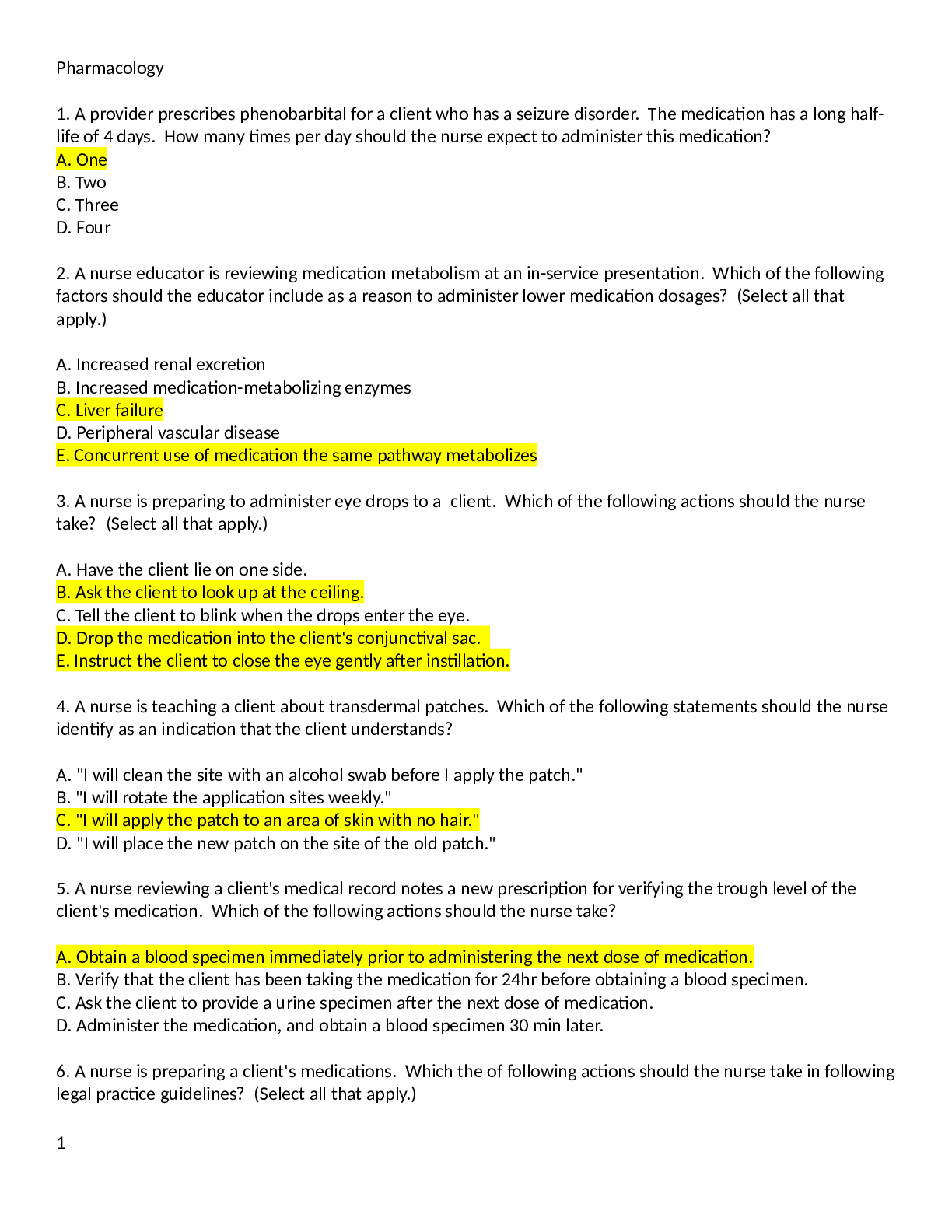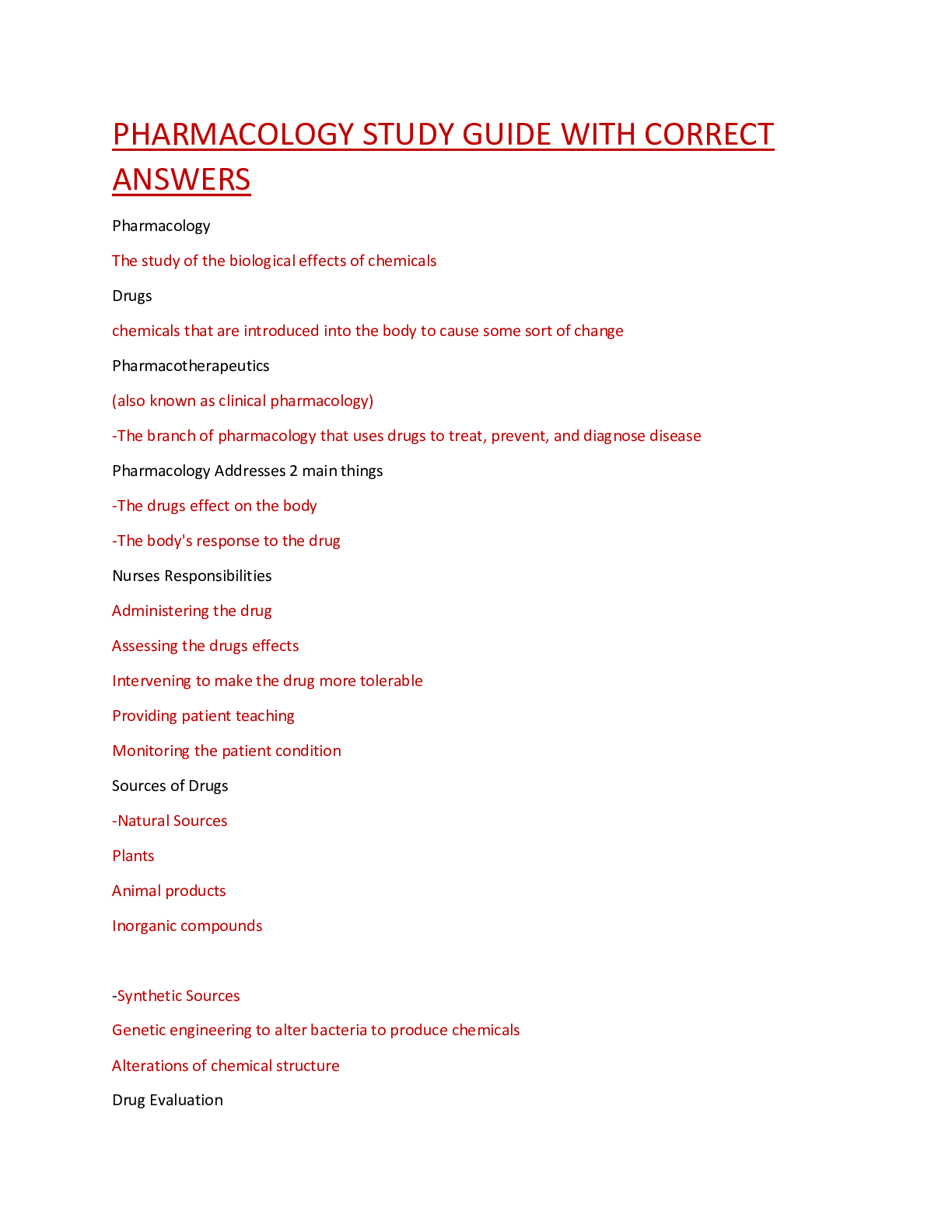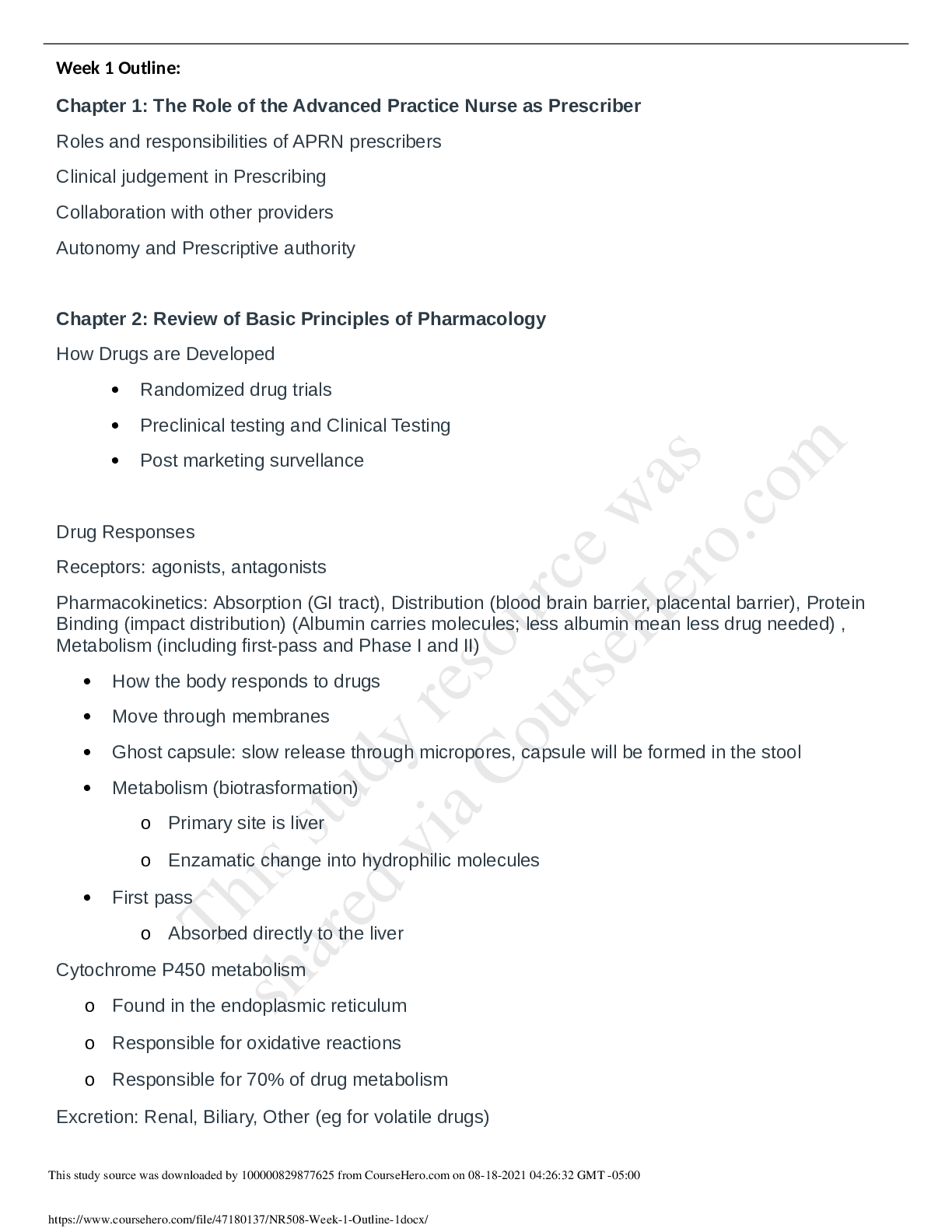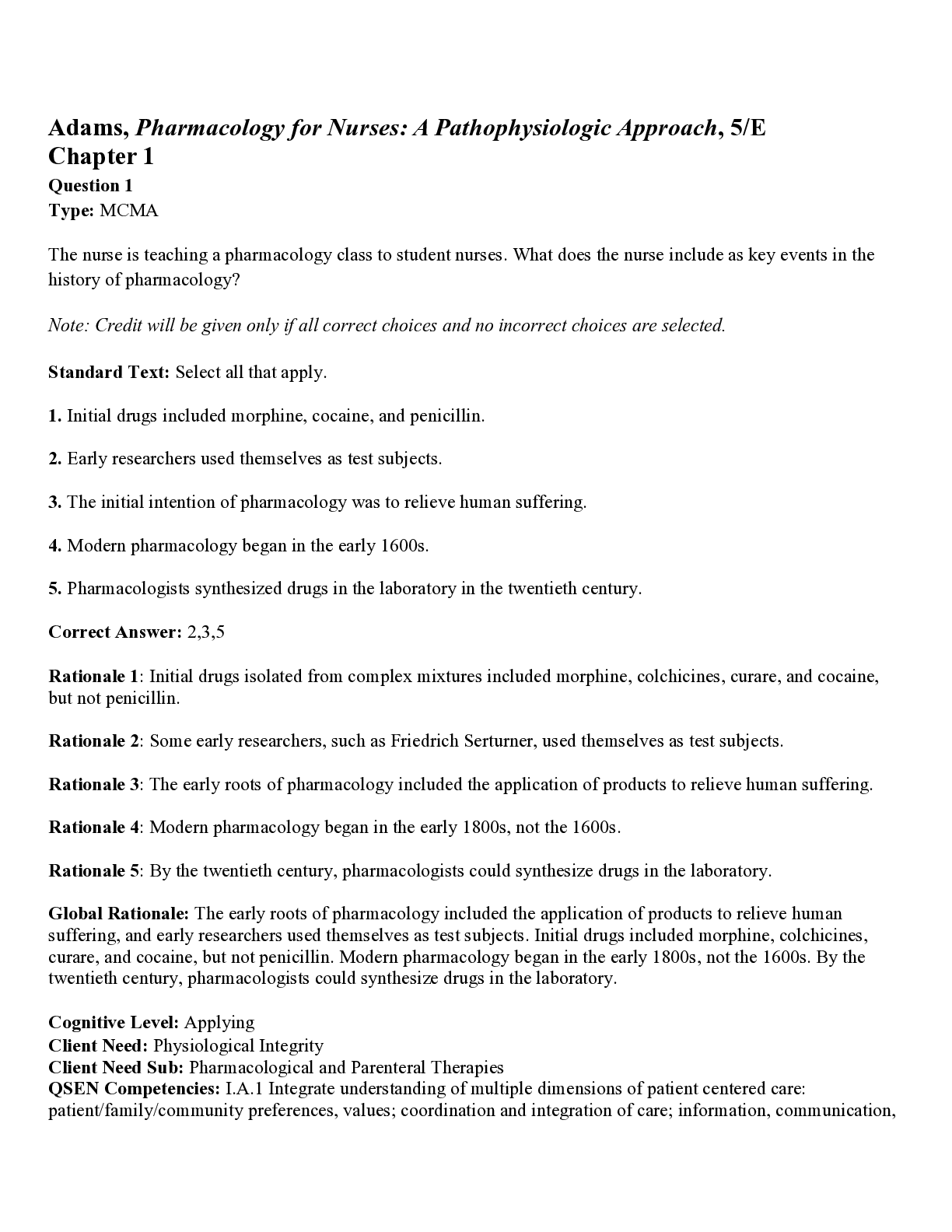*NURSING > STUDY GUIDE > NURSING 304 - SAUNDERS ATI PHARMACOLOGY STUDY GUIDE (2020/2021) Complete Solution, A Guide. (All)
NURSING 304 - SAUNDERS ATI PHARMACOLOGY STUDY GUIDE (2020/2021) Complete Solution, A Guide.
Document Content and Description Below
NURSING 304 - SAUNDERS ATI PHARMACOLOGY STUDY GUIDE;Answers and Rationales Chaminade University. SAUNDERS ATI PHARMACOLOGY STUDY GUIDE Week 1: Chapter 35 “Maternity and Newborn Medications” Questi... ons 1. The nurse is monitoring a client who is receiving oxytocin (Pitocin) to induce labor. Which assessment finding would cause the nurse to immediately discontinue the oxytocin infusion? 2. A pregnant client is receiving magnesium sulfate for the management of preeclampsia. The nurse determines that the client is experiencing toxicity from the medication if which finding is noted on assessment? 3. The nurse is monitoring a client in preterm labor who is receiving intravenous magnesium sulfate. The nurse should monitor for which adverse effects of this medication? Select all that apply. 4. The nurse instructor asks a nursing student to describe the procedure for administering erythromycin ointment to the eyes of a newborn. Which student statement indicates that further teaching is needed? 5. A client in preterm labor (31 weeks) who is dilated to 4 cm has been started on magnesium sulfate and contractions have stopped. If the client’s labor can be inhibited for the next 48 hours, the nurse anticipates a prescription for which medication? 6. Methylergonovine (Methergine) is prescribed for a woman to treat postpartum hemorrhage. Before administration of methylergonovine, what is the priority nursing assessment? 7. The nurse is preparing to administer beractant (Survanta) to a premature infant who has respiratory distress syndrome. The nurse plans to administer the medication by which route? 8. An opioid analgesic is administered to a client in labor. The nurse assigned to care for the client ensures that which medication is readily available if respiratory depression occurs? 9. Rho(D) immune globulin (RhoGAM) is prescribed for a client after delivery and the nurse provides information to the client about the purpose of the medication. The nurse determines that the woman understands the purpose if the woman states that it will protect her next baby from which condition? 10. Methylergonovine (Methergine) is prescribed for a client with postpartum hemorrhage. Before administering the medication, the nurse contacts the health care provider who prescribed the medication if which condition is documented in the client’s medical history? Chapter 49: “Pediatric Med. Administration and Calculations” 1. The nurse is providing medication instructions to a parent. Which statement by the parent indicates a need for further instruction? 2. A health care provider’s prescription reads “ampicillin sodium 125 mg IV every 6 hours.” The medication label reads “1 g and reconstitute with 7.4 mL of bacteriostatic water.” The nurse prepares to draw up how many mL to administer one dose? 3. A pediatric client with ventricular septal defect repair is placed on a maintenance dosage of digoxin (Lanoxin). The dosage is 0.07 mg/ kg/ day, and the client’s weight is 7.2 kg. The health care provider (HCP) prescribes the digoxin to be given twice daily. The nurse prepares how much digoxin to administer to the client at each dose? 4. Sulfisoxazole (Gantrisin), 1 g orally four times daily, is prescribed for an adolescent with a urinary tract infection. The medication label reads “500-mg tablets.” The nurse has determined that the dosage prescribed is safe. The nurse administers how many tablets per dose to the adolescent? 5. Penicillin G procaine (Wycillin), 1,000,000 units IM (intramuscularly), is prescribed for a child with an infection. The medication label reads “1,200,000 units per 2 mL.” The nurse has determined that the dose prescribed is safe. The nurse administers how many milliliters per dose to the child? 6. The nurse prepares to administer an intramuscular injection to a 4-month-old infant. The nurse selects which best site to administer the injection? 7. Atropine sulfate, 0.6 mg intramuscularly, is prescribed for a child preoperatively. The nurse has determined that the dose prescribed is safe and prepares to administer how many milliliters to the child? Fill in the blank (refer to figure). Week 2: Chapter 51 Integumentary Medications 1. Salicylic acid is prescribed for a client with a diagnosis of psoriasis. The nurse monitors the client, knowing that which finding indicates the presence of systemic toxicity from this medication? 2. The health education nurse provides instructions to a group of clients regarding measures that will assist in preventing skin cancer. Which instructions should the nurse provide?” 3. Mafenide acetate (Sulfamylon) is prescribed for a client with a burn injury. When applying the medication, the client complains of local discomfort and burning. The nurse should take which most appropriate action? 4. A burn client is receiving treatments of topical mafenide acetate (Sulfamylon) to the site of injury. The nurse monitors the client, knowing that which finding indicates that a systemic effect has occurred?” 5. Isotretinoin (Amnesteem or Claravis) is pre“scribed for a client with severe acne. Before the administration of this medication, the nurse anticipates that which laboratory test will be prescribed? 6. A client with severe acne is seen in the clinic and the health care provider (HCP) prescribes isotretinoin (Amnesteem or Claravis). The nurse reviews the client’s medication record and would contact the HCP if the client is taking which medication?” 7. The nurse is applying a topical corticosteroid to a client with eczema. The nurse should monitor for the potential for increased systemic absorption of the medication if the medication were being applied to which body area?” 8. The clinic nurse is performing an admission assessment on a client and notes that the client is taking azelaic acid (Azelex). Because of the medication Rx, the nurse would suspect that the client is being treated for which condition? 9. Silver sulfadiazine (Silvadene, Thermazene, SSD cream) is prescribed for a client with a partial-thickness burn and the nurse provides teaching about the medication. Which statement made by the client indicates a need for further teaching about the treatments? 10. The camp nurse asks the children preparing to swim in the lake if they have applied sunscreen. The nurse reminds the children that chemical sunscreens are most effective when applied at which times? Week 2: Chapter 53 Antineoplastic Medications Questions 1. Chemotherapy dosage is frequently based on total body surface area (BSA), so it is important for the nurse to perform which assessment before administering chemotherapy? 2. A client with squamous cell carcinoma of the larynx is receiving bleomycin intravenously. The nurse caring for the client anticipates that which diagnostic study will be prescribed? 3. A client with acute myelocytic leukemia is being treated with busulfan (Myleran, Busulfex). Which laboratory value would the nurse specifically monitor during treatment with this medication? 4. A client with small cell lung cancer is being treated with etoposide (Toposar). The nurse monitors the client during administration, knowing that which adverse effect is specifically associated with this medication? 5. A clinic nurse prepares a teaching plan for a client receiving an antineoplastic medication. When implementing the plan, the nurse should make which statement to the client? 6. “A client with ovarian cancer is being treated with vincristine (Vincasar). The nurse monitors the client, knowing that which manifestation indicates an AE specific to this medication? 7. The nurse is reviewing the history and physical examination of a client who will be receiving asparaginase (Elspar), an antineoplastic agent. The nurse contacts the health care provider before administering the medication if which disorder is documented in the client’s history? 8. Tamoxifen citrate is prescribed for a client with metastatic breast carcinoma. The nurse administering the medication understands that which is the primary action of this medication? 9. A client with metastatic breast cancer is receiving tamoxifen. The nurse specifically monitors which laboratory value while the client is taking this medication? 10. Megestrol acetate (Megace), an antineoplastic medication, is prescribed for a client with metastatic endometrial carcinoma. The nurse reviews the client’s history and should contact the health care provider if which diagnosis is documented in the client’s history? 11. The nurse is monitoring the intravenous (IV) infusion of an antineoplastic medication. During the infusion, the client complais of pain at the insertion site. On inspection of the site, the nurse notes redness and swelling and that the infusion of the medication has slowed in rate. The nurse suspects extravasation and should take which actions? 12. The nurse is analyzing the laboratory results of a client with leukemia who has received a regimen of chemotherapy. Which laboratory value would the nurse specifically note as a result of the massive cell destruction that occurred from the chemotherapy? 13. The nurse is providing medication instructions to a client with breast cancer who is receiving cyclophosphamide. The nurse should tell the client to take which action? 14. A client with non–Hodgkin’s lymphoma is receiving daunorubicin (DaunoXome). Which finding would indicate to the nurse that the client is experiencing an AE r/t the medication? 15. The nurse is monitoring the laboratory results of a client receiving an antineoplastic medication by the intravenous route. The nurse plans to initiate bleeding precautions if which laboratory result is noted? Chapter 55 Endocrine Medications 600. The nurse is teaching a client how to mix regular insulin and NPH insulin in the same syringe. Which action, if performed by the client, indicates the need for further teaching? a. withdraws the NPH insulin first b. withdraws the regular insulin first c. injects air into NPH insulin vial first d. injects an amount of air equal to the desired dose of insulin into each vial 601. The home care nurse visits a client recently diagnosed with diabetes mellitus who is taking Humulin NPH insulin daily. The client asks the nurse how to store the unopened vials of insulin. The nurse should tell the client to take which action? a. freeze the insulin b. refrigerate the insulin c. store the insulin in a dark, dry place. d. keep the insulin at room temperature 602. Glimepiride (Amaryl) is prescribed for a client with diabetes mellitus. The nurse instructs the client to avoid consuming which food while taking this medication? a. alcohol b. organ meats c. whole-grain cereals d. carbonated beverages 603. Sildenafil (Viagra) is prescribed to treat a client with erectile dysfunction. The nurse reviews the client’s medical record and should question the prescription if which data is noted in the client’s history? a. insomnia b. neuralgia c. use of nitroglycerin d. use of multivitamins 604. The health care provider (HCP) prescribes exenatide (Byetta) for a client with type 1 diabetes mellitus who takes insulin. The nurse should plan to take which most appropriate intervention? a. withhold the medication and call the HCP, questioning the prescription for the client. b. administer the medication within 60 minutes before the morning and evening meal. c. monitor the client for gastrointestinal side effects after administering the medication. d. withdraw the insulin from the prefilled pen into an insulin syringe to prepare for administration. 605. A client is taking Humulin NPH insulin and regular insulin every morning. The nurse should provide which instructions to the client? Select all that apply a. hypoglycemia may be experiences before dinnertime. b. the insulin dose should be decreased if illness occurs. c. the insulin should be administered at room temperature. d. the insulin vial needs to be shaken vigorously to break up the precipitates. c. the NPH insulin should be drawn into the syringe first, then the regular insulin. 606. The home health care nurse is visiting a client who was recently diagnosed with type 2 diabetes mellitus. The client is prescribed repaglinide (Prandin) and metformin (Glucophage) and asks the nurse to explain these medications. The nurse should provide which instructions to the client? Select all that apply. a. diarrhea may occur secondary to the metformin. b. the repalginide is not taken if a meal is skipped. c. the repaglinide is taken 30 minutes before eating. d. a simple sugar food item is carried and used to treat mild hypoglycemia associated with repaglinide. e. muscle pain is an expected effect of metformin and may be treated with acetaminophen (Tylenol). 607. The community health nurse visits a client at home. Prednisone, 10mg orally daily, has been prescribed for the client and the nurse teaches the client about the medication. Which statement, if made by the client, indicates that further teaching is necessary? a. “I can take aspirin or my antihistamine if I need it.” b. “I need to take the medication every day at the same time.” c. “I need to avoid coffee, tea, cola, and chocolate in my diet.” d. “If I gain more than 5 pounds a week, I will call my health care provider (HCP). 608. A client with hyperthyroidism has been given methimazole (Tapazole). Which nursing considerations are associated with this medication? Select all that apply. a. administer methimazole with food. b. place the client on a low-calorie, low-protein diet. c. assess the client for unexplained bruising or bleeding. d. instruct the client to report side/adverse effects such as sore throat, fever, or headaches e. use special radioactive precautions when handling the clients urine for the first 24 hours following initial administration. 609. The nurse is monitoring a client receiving levothyroxine sodium (Synthroid) for hypothyroidism. Which findings indicate the presence of a side effect associated with this medication? Select all that apply. a. insomnia b. weight loss c. bradycardia d. constipation e. mild heat intolerance 610. The nurse provides instructions to a client who is taking levothyroxine (Synthroid). The nurse should tell the client to take the medication at which time? a. with food b. at lunchtime c. on an empty stomach d. at bedtime with a snack 611. The nurse provides medication instructions to a client who is taking levothyroxine (Synthroid) and should tell the client to notify the health care provider (HCP) if which problem occurs? a. fatigue b. tremors c. cold intolerance d. excessively dry skin 612. The nurse performs an admission assessment on a client who visits a health care clinic for the first time. The client tells the nurse that propylthiouracil (PTU) is taken daily. The nurse continues to collect data from the client, suspecting that the client has a history of which condition? a. myxedema b. graves’ disease c. addison’s disease d. cushing’s syndrome 613. The nurse is instructing a client regarding intranasal desmopressin (DDAVP). The nurse should tell the client that which occurrence is a side effect of the medication? a. headache b. vulval pain c. runny nose d. flushed skin 614. A daily dose of prednisone is prescribed for a client. The nurse provides instructions to the client regarding administration of the medication and should instruct the client that which time is best to take this medication? a. at noon b. at bedtime c. early morning d. any time, at the same time, each day 615. Prednisone is prescribed for a client with diabetes mellitus who is taking Humulin NPH insulin daily. Which prescription change does the nurse anticipate during therapy with the prednisone? a. an additional dose of prednisone daily b. a decreased amount of daily Humulin NPH insulin c. an increased amount of daily Humulin NPH insulin d. the addition of an oral hypoglycemic medication daily 616. A client with diabetes mellitus visits a health care clinic. The clients diabetes mellitus previously had been well controlled with glyburide (DiaBeta) daily, but recently the fasting blood glucose level has been 180 to 200 mg/dL. Which medication, if added to the clients regimen, may have contributed to the hyperglycemia? a. Prednisone b. Phenelzine (Nardil) c. Atenolol (Tenormin) d. Allopurinol (Zyloprim) Chapter 57: GI Medications 643. A client with Crohn’s disease is scheduled to receive an infusion of infliximab (Remicade). What intervention by the nurse will determine the effectiveness of treatment? a. monitoring the leukocyte count for 2 days after the infusion. b. checking the frequency and consistency of bowel movements. c. checking serum liver enzyme levels before and after the infusion d. carrying out a Hematest on gastric fluids after the infusion is completed. 644. A client has a PRN prescription for loperamide hydrochloride (Imodium). For which condition should the nurse administer this medication? a. constipation b. abdominal pain c. an episode of diarrhea d. hematest-positive nasogastric tube drainage 645. A client has a PRN prescription for ondansetron (Zofran). For which condition should the nurse administer this medication to the postoperative client? a. paralytic ileus b. incisional pain c. urinary retention d. nausea and vomiting 646. A client has begun medication therapy with pancrelipase (Pancrease MT,). The nurse evaluates that the medication is having the optimal intended benefit if which effect is observed? a. weight loss b. relief of heartburn c. reduction of steatorrhea d. absence of abdominal pain 647. An older client recently has been taking cimetidine (Tagamet). The nurse monitors the client for which most frequent central nervous system side effect of this medication? a. tremors b. dizziness c. confusion d. hallucination 648. A client with a gastric ulcer has a prescription for sucralfate (Carfate), 1g by mouth four times daily. The nurse should schedule the medication for which times? a. with meals and at bedtime b. every 6 hours around the clock c. one hour after meals and at bedtime d. one hour before meals and at bedtime 649. A client who chronically uses nonsteroidal anti-inflammatory drugs (NSAIDS) had been taking misoprostol (Cytotec). The nurse determines that the medication is having the intended therapeutic effect if which finding is noted? a. resolved diarrhea b. relief of epigastric pain c. decreased platelet count d. decreased white blood cell count 650. A client has been taking omeprazole (Prilosec) for 4 weeks. The ambulatory care nurse evaluates that the client is receiving the optimal intended effect of the medication if the client reports the absence of which symptom? a. diarrhea b. heartburn c. flatulence d. constipation 651. A client with a peptic ulcer is diagnosed with a Helicobactor pylori infection. The nurse is teaching the client about the medicaitons prescribed, including clarithromycin (Biaxin), esomeprazole (Nexium), and amoxicillin (Amoxil). Which statement by the client indicates the best understanding of the medication regimen? a. “My ulcer will heal because these medications will kill the bacteria.” b. “These medicaitons are only taken when I have pain from my ulcer.” c. “The medicaitons will kill the bacteria and stop the acid production.” d. “These medications will coat the ulcer and decrease the acid production in my stomach.” 652. A client has a new prescription for metoclopramide (Reglan). On review of the chart, the nurse identifies that this medication can be safely administered with which condition? a. intestinal obstruction b. peptic ulcer with melena c. diverticulitis with perforation d. vomiting following cancer chemotherapy 653. A histamine (H2)receptor antagonist will be prescribed for a client. The nurse understands that which medications are H2 –receptor antagonist? Select all that apply. a. Nizatidine (Axid) b. Ranitidine (Zantac) c. Famotidine (Pepcid) d. Cimetidine (Tagamet) e. Esomeprazole (Nexium) f. Lansoprazole (Prevacid) 654. The nurse has given instructions to a client who has just been prescribed cholestyramine (Questran). Which statement by the client indicates a need for further instructions? a. “I will continue taking vitamin supplements.” b. “This medication will help lower my cholesterol.” c. “This medication should only be taken with water.” d. “A high-fiber diet is important while taking this medication.” Chapter 59 679. A client has a prescription to take guaifenesin (Mucinex). The nurse determines that the client understands the proper administration of this medication if the client states that he or she will perform which action? 1. Take an extra dose if fever develops 2. Take the medication with meals only 3. Take the tablet with a full glass of water 4. Decrease the amount of daily fluid intake 680. The nurse is preparing to administer a dose of naloxone hydrochloride intravenously to a client with an intravenous opioid overdose. Which supportive medical equipment should the nurse plan to have at the client’s bedside if needed? 1. Nasogastric tube 2. Paracentesis tray 3. Resuscitation equipment 4. Central line insertion tray 681. The nurse teaches a client about the effects of diphenhydramine (Benadryl), which has been prescribed as a cough suppressant. The nurse determines that the client needs further instruction if the client makes which statement? 1. “I will take the medication on an empty stomach.” 2. “I won’t drink alcohol while taking this medication.” 3. “I will use sugarless gum, candy, or oral rinses to decrease dryness in my mouth.” 4. “I won’t do activities that require mental alertness while taking this medication.” 682. A cromolyn sodium inhaler is prescribed for a client with allergic asthma. The nurse provides instructions regarding the side and adverse effects of this medication and should tell the client that which undesirable effect is associated with this medication? 1. Insomnia 2. Constipation 3. Hypotension 4. Bronchospasm 683. Terbutaline is prescribed for a client with bronchitis. The nurse understands that this medication should be used with caution if which medical condition is present in the client? 1. Osteoarthritis 2. Hypothyroidism 3. Diabetes mellitus 4. Polycystic disease 684. Zafirlukast (Accolate) is prescribed for a client with bronchial asthma. Which laboratory test does the nurse expect to be prescribed before the administration of this medication? 1. Platelet count 2. Neutrophil count 3. Liver function tests 4. Complete blood count 685. A client has been taking isoniazid for 11⁄2 months. The client complains to the nurse about numbness, paresthesias, and tingling in the extremities. The nurse interprets that the client is experiencing which problem? 1. Hypercalcemia 2. Peripheral neuritis 3. Small blood vessel spasm 4. Impaired peripheral circulation 686. A client is to begin a 6-month course of therapy with isoniazid. The nurse should plan to teach the client to take which action? 1. Use alcohol in small amounts only. 2. Report yellow eyes or skin immediately. 3. Increase intake of Swiss or aged cheeses. 4. Avoid vitamin supplements during therapy. 687. A client has been started on long-term therapy with rifampin (Rifadin). The nurse should provide which information to the client about the medication? 1. Should always be taken with food or antacids 2. Should be double-dosed if one dose is forgotten 3. Causes orange discoloration of sweat, tears, urine, and feces 4. May be discontinued independently if symptoms are gone in 3 months 688. The nurse has given a client taking ethambutol (Myambutol) information about the medication. The nurse determines that the client understands the instructions if the client states he or she will immediately report which finding? 1. Impaired sense of hearing 2. Gastrointestinal side effects 3. Orange-red discoloration of body secretions 4. Difficulty in discriminating the color red from green 689. A client with tuberculosis is being started on antituberculosis therapy with isoniazid. Before giving the client the first dose, the nurse should ensure that which baseline study has been completed? 1. Electrolyte levels 2. Coagulation times 3. Liver enzyme levels 4. Serum creatinine level 690. The nurse has a prescription to give a client salmeterol (Serevent Diskus), two puffs, and beclomethasone dipropionate (Qvar), two puffs, by metered-dose inhaler. The nurse should administer the medication using which procedure? 1. Beclomethasone first and then the salmeterol 2. Salmeterol first and then the beclomethasone 3. Alternating a single puff of each, beginning with the salmeterol 4. Alternating a single puff of each, beginning with the beclomethasone 691. Rifabutin (Mycobutin) is prescribed for a client with active Mycobacterium avium complex (MAC) disease and tuberculosis. For which side/ adverse effects of the medication should the nurse monitor? Select all that apply. 1. Signs of hepatitis 2. Flulike syndrome 3. Low neutrophil count 4. Vitamin B6 deficiency 5. Ocular pain or blurred vision 6. Tingling and numbness of the fingers 692. A client has begun therapy with theophylline (Theo-24). The nurse should plan to teach the client to limit the intake of which items while taking this medication? 1. Coffee, cola, and chocolate 2. Oysters, lobster, and shrimp 3. Melons, oranges, and pineapple 4. Cottage cheese, cream cheese, and dairy creamers 693. The nurse has just administered the first dose of omalizumab (Xolair) to a client. Which statement by the client would alert the nurse that the client may be experiencing a life-threatening effect? 1. “I have a severe headache.” 2. “My feet are quite swollen.” 3. “I am nauseated and may vomit.” 4. “My lips and tongue are swollen.” 694. The nurse is caring for a client with a diagnosis of influenza who first began to experience symptoms yesterday. Antiviral therapy is prescribed and the nurse provides instructions to the client about the therapy. Which statement by the client indicates an understanding of the instructions? 1. “I must take the medication exactly as prescribed.” 2. “Once I start the medication, I will no longer be contagious.” 3. “I will not get any colds or infections while taking this medication.” 4. “This medication has minimal side effects and I can return to normal activities.” Chapter 61: Cardiovascular Medications Questions 720. A client with atrial fibrillation is receiving a continuous heparin infusion at 1000 units/ hour. The nurse determines that the client is receiving the therapeutic effect based on which results? 1. Prothrombin time of 12.5 seconds 2. Activated partial thromboplastin time of 60 seconds 3. Activated partial thromboplastin time of 28 seconds 4. Activated partial thromboplastin time longer than 120 seconds 721. The nurse provides discharge instructions to a client who is taking warfarin sodium (Coumadin). Which statement, by the client, reflects the need for further teaching? 1. “I will avoid alcohol consumption.” 2. “I will take my pills every day at the same time.” 3. “I have already called my family to pick up a Medic-Alert bracelet.” 4. “I will take Ecotrin (enteric-coated aspirin) for my headaches because it is coated.” 722. A client who is receiving digoxin (Lanoxin) daily has a serum potassium level of 3 mEq/ L and is complaining of anorexia. The health care provider prescribes determination of the serum digoxin level to rule out digoxin toxicity. The nurse checks the results, knowing that which value is the therapeutic serum level (range) for digoxin? 1. 0.5 to 2 ng/ mL 2. 1.2 to 2.8 ng/ mL 3. 3.0 to 5.0 ng/ mL 4. 3.5 to 5.5 ng/ mL 723. A client is being treated with procainamide for a cardiac dysrhythmia. Following intravenous administration of the medication, the client complains of dizziness. What intervention should the nurse take first? 1. Measure the heart rate on the rhythm strip. 2. Administer prescribed nitroglycerin tablets. 3. Obtain a 12-lead electrocardiogram immediately. 4. Auscultate the client’s apical pulse and obtain a blood pressure. 724. The nurse is monitoring a client who is taking propranolol (Inderal LA). Which assessment data indicates a potential serious complication associated with this medication? 1. The development of complaints of insomnia 2. The development of audible expiratory wheezes 3. A baseline blood pressure of 150/ 80 mm Hg followed by a blood pressure of 138/ 72 mm Hg after two doses of the medication 4. A baseline resting heart rate of 88 beats/ minute followed by a resting heart rate of 72 beats/ minute after two doses of the medication 725. A client with atrial fibrillation secondary to mitral stenosis is receiving a heparin sodium infusion at 1000 units/ hour and warfarin sodium (Coumadin) 7.5 mg at 5: 00 PM daily. The morning laboratory results are as follows: activated partial thromboplastin time (aPTT) = 32 seconds; internationalized normalized ratio (INR) = 1.3. The nurse should plan to take which action based on the client’s laboratory results? 1. Collaborate with the health care provider (HCP) to discontinue the heparin infusion and administer the warfarin sodium as prescribed. 2. Collaborate with the HCP to obtain a prescription to increase the heparin infusion and administer the warfarin sodium as prescribed. 3. Collaborate with the HCP to withhold the warfarin sodium since the client is receiving a heparin infusion and the aPTT is within the therapeutic range. 4. Collaborate with the HCP to continue the heparin infusion at the same rate and to discuss use of dabigatran etexilate (Pradaxa) in place of warfarin sodium. 726. A client is diagnosed with an ST-segment elevation myocardial infarction (STEMI) and is receiving tissue plasminogen activator, alteplase (Activase, tPA). Which action is a priority nursing intervention? 1. Monitor for kidney failure. 2. Monitor psychosocial status. 3. Monitor for signs of bleeding. 4. Have heparin sodium available. 727. The nurse is planning to administer hydrochlorothiazide to a client. The nurse understands that which is a concern related to the administration of this medication? 1. Hypouricemia, hyperkalemia 2. Increased risk of osteoporosis 3. Hypokalemia, hyperglycemia, sulfa allergy 4. Hyperkalemia, hypoglycemia, penicillin allergy 728. The home health care nurse is visiting a client with elevated triglyceride levels and a serum cholesterol level of 398 mg/ dL. The client is taking cholestyramine (Questran). Which statement, by the client, indicates the need for further education? 1. “Constipation and bloating might be a problem.” 2. “I’ll continue to watch my diet and reduce my fats.” 3. “Walking a mile each day will help the whole process.” 4. “I’ll continue my nicotinic acid from the health food store.” 729. The nurse is monitoring a client who is taking digoxin (Lanoxin) for adverse effects. Which findings are characteristic of digoxin toxicity? Select all that apply. 1. Tremors 2. Diarrhea 3. Irritability 4. Blurred vision 5. Nausea and vomiting 730. Prior to administering a client’s daily dose of digoxin, the nurse reviews the client’s laboratory data and notes the following results: serum calcium, 9.8 mg/ dL; serum magnesium, 1.2 mg/ dL; serum potassium, 4.1 mEq/ L; serum creatinine, 0.9 mg/ dL. Which result should alert the nurse that the client is at risk for digoxin toxicity? 1. Serum calcium level 2. Serum potassium level 3. Serum creatinine level 4. Serum magnesium level 731. A client being treated for heart failure is administered intravenous bumetanide. Which outcome indicates the medication has achieved the expected effect? 1. Cough becomes productive of frothy pink sputum 2. The serum potassium level changes from 3.8 to 3.1 mEq/ L 3. B-natriuretic peptide (BNP) factor increases from 200 to 262 pg/ mL 4. Urine output increases from 10 mL/ hour to greater than 50 mL hourly 732. Intravenous heparin therapy is prescribed for a client. While implementing this prescription, the nurse ensures that which medication is available on the nursing unit? 1. Vitamin K 2. Protamine sulfate 3. Potassium chloride 4. Aminocaproic acid (Amicar) 733. A client receiving thrombolytic therapy with a continuous infusion of alteplase (Activase) suddenly becomes extremely anxious and complains of itching. The nurse hears stridor and notes generalized urticaria and hypotension. Which nursing action is the priority? 1. Administer oxygen and protamine sulfate. 2. Cut the infusion rate in half and sit the client up in bed. 3. Stop the infusion and call the health care provider (HCP). 4. Administer diphenhydramine (Benadryl) and continue the infusion. 734. The nurse should report which assessment finding to the health care provider (HCP) before initiating thrombolytic therapy in a client with pulmonary embolism? 1. Adventitious breath sounds 2. Temperature of 99.4 ° F orally 3. Blood pressure of 198/ 110 mm Hg 4. Respiratory rate of 28 breaths/ minute 735. A client is prescribed nicotinic acid (niacin) for hyperlipidemia and the nurse provides instructions to the client about the medication. Which statement by the client indicates an understanding of the instructions? 1. “It is not necessary to avoid the use of alcohol.” 2. “The medication should be taken with meals to decrease flushing.” 3. “Clay-colored stools are a common side effect and should not be of concern.” 4. “Ibuprofen (Motrin) taken 30 minutes before the nicotinic acid should decrease the flushing.” Chapter 63: Renal Medications #756 A client who has a cold is seen in the emergency department with an inability to void. Because the client has a history of benign prostatic hyperplasia, the nurse determines that the client should be questioned about the use of which medication? 1. Diuretics 2. Antibiotics 3. Antitussives 4. Decongestants #757 Nitrofurantoin (Macrodantin) is prescribed for a client with a urinary tract infection. The client contacts the nurse and reports a cough, chills, fever, and difficulty breathing. The nurse should make which interpretation about the client’s complaints? 1. The client may have contacted the flu. 2. The client is experiencing anaphylaxis. 3. The client is experiencing expected effect of the medication. 4. The client is experiencing a pulmonary reaction requiring cessation of the medication. #758 The nurse is providing discharge instructions to a client receiving sulfamethoxazole. Which instruction should be included in the list? 1. Restrict fluid intake. 2. Maintain a high fluid intake. 3. If the urine turns dark drown, call the health care provider (HCP) immediately. 4. Decrease the dosage when symptoms are improving to prevent an allergic response. #759 Trimethoprim-sulfamethoxazole (TMP-SMZ); Bactrim) is prescribed for a client. The nurse should instruct the client to report which symptom if it develops during the course of this medication therapy? 1. Nausea 2. Diarrhea 3. Headache 4. Sore throat #760 Phenazopyridine (Pyridium) is prescribed for a client for symptomatic relief of pain resulting from a lower urinary tract infection. The nurse should provide the client with which information regarding this medication? 1. Take the medication at bedtime. 2. Take the medication before meals. 3. Discontinue the medication if a headache occurs. 4. A reddish orange discoloration of the urine may occur. #761 Bethanechol chloride (Urecholine) is prescribed for a client with urinary retention. Which disorder would be a contraindication to the administration of this medication? 1. Gastric atony 2. Urinary strictures 3. Neurogenic atony 4. Gastroesophageal reflux #762 The nurse, who is administering bethanechol chlorine (Urecholine), is monitoring for cholinergic overdose associated with the medication. The nurse should check the client for which sign of overdose? 1. Dry skin 2. Dry mouth 3. Bradycardia 4. Signs of dehydration #763 Oxybutinin chloride (Ditropan XL) is prescribed for a client with neurogenic bladder. Which sign would indicate a possible toxic effect related to the medication? 1. Pallor 2. Drowsiness 3. Bradycardia 4. Restlessness #764 Following kidney transplantation, cyclosporine (Sandimmune) is prescribed for a client. Which laboratory result would indicate an adverse effect from the use of this medication? 1. Normal hemoglobin level 2. Decreased creatinine level 3. Decreased white blood cell count 4. Elevated blood urea nitrogen level #765 The nurse is providing dietary instructions to a client who has been prescribed cyclosporine (Sandimmune). Which food item should the nurse instruct the client to exclude from the diet? 1. Red meats 2. Orange juice 3. Grapefruit juice 4. Green leafy vegetables #766 Tacrolimus (Prograf) is prescribed for a client. Which disorder, if noted in the client’s record, would indicate that the medication needs to be administered with caution? 1. Pancreatitis 2. Ulcerative colitis 3. Diabetes insipidus 4. Coronary artery disease #767 The nurse is reviewing the laboratory results for a client receiving tacrolimus (Prograf). Which laboratory result would indicate to the nurse that the client is experiencing an adverse effect of the medication? 1. Blood glucose of 200 mg/dL 2. Potassium level of 3.8 mEq/L 3. Platelet count of 300,000 cells/mm3 4. White blood cell count of 6000 cells/mm3 #768 The nurse receives a call from a client concerned about eliminating brown-colored urine after taking nitrofurantoin (Furadantin) for a urinary tract infection. The nurse should make which appropriate response? 1. “Discontinue taking the medication and make an appointment for a future urine culture.” 2. “Decrease your medication to half the dose because your urine is too concentrated.” 3. “Continue taking the medication because the urine is discolored from the medication.” 4. “Take magnesium hydroxide (Maalox) with your medication to lighten the urine color.” #769 A client with chronic kidney disease is receiving epoetin alfa (Epogen). Which laboratory result would indicate a therapeutic effect of the medication? 1. Hematocrit of 32% 2. Platelet 400,000 cells/mm3 3. Blood urea nitrogen level of 15 mg/dL 4. White blood cell count of 6000 cells/mm3 A client with a urinary tract infection is receiving ciprofloxacin (Cipro) by the intravenous (IV) route. Nurse appropriately administers the medication by performing which action? 1. Infusing slowly over 60 minutes. 2. Infusing in light-protective bag. 3. Infusing only through a central line. 4. Infusing rapidly as direct IVP Chapter 65: Optic & Ophthalmic Betaxolol hydrochloride eyedrops have been prescribed for a client with glaucoma. Which nursing action is most appropriate related to monitoring for side/adverse effects of this medication? 1. Monitoring temperature 2. Monitoring blood pressure 3. Assessing peripheral pulses 4. Assessing blood glucose level The nurse is preparing to administer eyedrops. Which interventions should the nurse take to administer the drops? Select all that apply. 1. Wash hands. 2. Put gloves on. 3. Place the drop in the conjunctival sac. 4. Pull the lower lid down against the cheekbone. 5. Instruct the client to squeeze the eyes shut after instilling the eye drop. 6. Instruct the client to tilt the head forward, open the eyes, and look down. The nurse prepares a client for an ear irrigation as prescribed by the healthcare provider. Which action should the nurse take when performing the procedure? 1. Warm the irrigation solution to 98.6° F. 2. Position the client with the affected side up following the irrigation. 3. Direct a slow steady stream of irrigation solution toward the eardrum. 4. Assist the client to turn his or her head so that the ear to be irrigated is facing upward. The nurse is providing instructions to a client who will be self-administering eyedrops. To minimize systemic absorption of the eyedrops, the nurse should instruct the client to take which action? 1. Eat before instilling the drops. 2. Swallow several times after instilling the eyedrops. 3. Blink vigorously to encourage tearing after instilling the drops. 4. Occlude the nasolacrimal duct with a finger after instilling the drops. A client is prescribed an eyedrop and an eye ointment for the right eye. How should the nurse best administer the medication? 1. Administer the eyedrop first, followed by the eye ointment. 2. Administer the eye ointment first, followed by the eyedrop. 3. Administer the eyedrop, wait 15 minutes, and administer the ointment. 4. Administer the ointment, wait 15 minutes, and administer the eyedrop. #795 Which medication, if prescribed for the client with glaucoma, should the nurse question? 1. Betaxolol (Betoptic) 2. Atropine sulfate (Isopto Atropine) 3. Pilocarpine hydrochloride (Isopto Carpine) 4. Pilocarpine (Ocusert Pilo-20, Ocusert Pilo-40) #796 A miotic medication has been prescribed for the client with glaucoma and the client asks the nurse about the purpose of the medication. Which response should the nurse provide to the client? 1. “The medication will help dilate the eye to prevent pressure from occurring.” 2. “The medication will relax the muscles of the eyes and prevent blurred vision.” 3. “The medication causes the pupil to constrict and will lower the pressure in the eye.” 4. “The medication will help block the responses that are sent to the muscles in the eye.” #797 A client was just admitted to the hospital to rule out a gastrointestinal (GI) bleed. The client has brought several bottles of medications prescribed by different specialists. During the admission assessment, the client states, “Lately, I have been hearing some roaring sounds in my ears, especially when I am alone.” Which medication would the nurse identify as the client’s complaint? 1. Doxycycline (Vibramycin) 2. Acetylsalicylic acid (Aspirin) 3. Atropine sulfate (Isopto Atropine) 4. Diltiazem hydrochloride (Cardizem) #798 In preparation for cataract surgery, the nurse is to administer cyclopentolate (Cyclogyl) eyedrops. The nurse understands what which characterizes the medication action? 1. Produces miosis of the operative eye 2. Dilates the pupil of the operative eye 3. Constricts the pupil of the operative eye 4. Provides lubrication to the operative eye Chapter 71 Immunologic Medications The client with acquired immunodeficiency syndrome and Pneumocystis jiroveci infection has been receiving pentamidine (Pentam 300). The client develops a temperature of 101° F. The nurse continues to assess the client, knowing that this sign most likely indicates which condition? 1. That the dose of the medication is too low 2. That the client is experiencing toxic effects of the medication 3. That the client has developed inadequacy of thermoregulation 4. That the client has developed another infection caused by leukopenic effects of the medication The nurse caring for a client who is taking an aminoglycoside should monitor the client for which adverse effects of the medication? Select all that apply. 1. Seizures 2. Ototoxicity 3. Renal toxicity 4. Dysrhythmias 5. Hepatotoxicity Ketoconazole is prescribed for a client with a diagnosis of candidiasis. Which interventions should the nurse include when administering this medication? Select all that apply. 1. Restrict fluid intake. 2. Monitor liver function studies. 3. Instruct the client to avoid alcohol. 4. Administer the medication with an antacid. 5. Instruct the client to avoid exposure to the sun. 6. Administer the medication on an empty stomach.” The nurse is caring for a client who has been taking a sulfonamide and should monitor for signs/symptoms of which side/adverse effects of the medication? Select all that apply. 1. Ototoxicity 2. Palpitations 3. Nephrotoxicity 4. Bone marrow depression 5. Gastrointestinal (GI) effects 6. Increased white blood cell (WBC) count” “The nurse is reviewing the results of serum laboratory studies drawn on a client with acquired immunodeficiency syndrome who is receiving didanosine (Videx). The nurse interprets that the client may have the medication discontinued by the health care provider if which elevated result is noted? 1. Serum protein level 2. Blood glucose level 3. Serum amylase level 4. Serum creatinine level” “ The nurse is caring for a postrenal transplantation client taking cyclosporine (Sandimmune). The nurse notes an increase in one of the client’s vital signs and the client is complaining of a headache. What vital sign is most likely increased? 1. Pulse 2. Respirations 3. Blood pressure 4. Pulse oximetry” “Amikacin (Amikin) is prescribed for a client with a bacterial infection. The nurse instructs the client to contact the health care provider (HCP) immediately if which occurs? 1. Nausea 2. Lethargy 3. Hearing loss 4. Muscle aches” “The nurse is assigned to care for a client with cytomegalovirus retinitis and acquired immunodeficiency syndrome who is receiving foscarnet, an antiviral medication. The nurse should monitor the results of which laboratory study while the client is taking this medication? 1. CD4 cell count 2. Lymphocyte count 3. Serum albumin level 4. Serum creatinine level” A client who is human immunodeficiency virus seropositive has been taking stavudine (d4T, Zerit). The nurse should monitor which most closely while the client is taking this medication? 1. Gait 2. Appetite 3. Level of consciousness 4. Gastrointestinal function Last week Chapter 77 948. A client’s medication sheet contains a prescription for sertraline (Zoloft). To ensure safe administration of the medication, how should the nurse administer the dose? 1. On an empty stomach 2. At the same time each evening 3. Evenly spaced around the clock 4. As needed when the client complains of depression* 949. A client with schizophrenia has been started on medication therapy with clozapine (Clozaril). The nurse should assess the results of which laboratory study to monitor for adverse effects from this medication? 1. Platelet count 2. Blood glucose level 3. Liver function studies 4. White blood cell count* 950. A client is scheduled for discharge and will be taking phenobarbital sodium (Luminal) for an extended period. The nurse would place highest priority on teaching the client which point that directly relates to client safety? 1. Take the medication only with meals. 2. Take the medication at the same time each day. 3. Use a dose container to help prevent missed doses. 4. Avoid drinking alcohol while taking this medication.* 951. The nurse is describing the medication side and adverse effects to a client who is taking oxazepam (Serax). What information should the nurse incorporate in the discussion? 1. Consume a low-fiber diet. 2. Increase fluids and bulk in the diet. 3. Rest if the heart begins to beat rapidly. 4. Take antidiarrheal agents if diarrhea occurs.* 952. The nurse is administering risperidone (Risperdal) to a client who is scheduled to be discharged. Before discharge, which instruction should the nurse provide to the client? 1. Get adequate sunlight. 2. Continue driving as usual. 3. Avoid foods rich in potassium. 4. Get up slowly when changing positions. 953. The nurse is teaching a client who is being started on imipramine (Tofranil) about the medication. The nurse should inform the client to expect maximum desired effects at what time period following initiation of the medication? 1. In 2 months 2. In 2 to 3 weeks 3. During the first week 4. During the sixth week of administration 954. A hospitalized client is started on phenelzine (Nardil) for the treatment of depression. The nurse should instruct the client that which foods are acceptable to consume while taking this medication? Select all that apply. 1. Figs 2. Yogurt 3. Crackers 4. Aged cheese 5. Tossed salad 6. Oatmeal raisin cookies* 955. The nurse notes that a client with schizophrenia and receiving an antipsychotic medication is moving her mouth, protruding her tongue, and grimacing as she watches television. The nurse determines that the client is experiencing which medication complication? 1. Parkinsonism 2. Tardive dyskinesia 3. Hypertensive crisis 4. Neuroleptic malignant syndrome* 956. The nurse is performing a follow-up teaching session with a client discharged 1 month ago. The client is taking fluoxetine (Prozac). What information would be important for the nurse to obtain during this client visit regarding the side/ adverse effects of the medication? 1. Cardiovascular symptoms 2. Gastrointestinal dysfunctions 3. Problems with mouth dryness 4. Problems with excessive sweating* 957. A client who has been taking buspirone (Buspar) for 1 month returns to the clinic for a follow-up assessment. The nurse determines that the medication is effective if the absence of which manifestation has occurred? 1. Paranoid thought process 2. Rapid heartbeat or anxiety 3. Alcohol withdrawal symptoms 4. Thought broadcasting or delusions* 958. A client taking lithium carbonate reports vomiting, abdominal pain, diarrhea, blurred vision, tinnitus, and tremors. The lithium level is 2.5 mEq/ L. This level is indicative of which finding? 1. Toxic 2. Normal 3. Slightly above normal 4. Excessively below normal* 959. A client gives the home health nurse a bottle of clomipramine (Anafranil). The nurse notes that the medication has not been taken by the client in 2 months. Which behavior observed in the client would validate noncompliance with this medication? 1. Complaints of insomnia 2. Complaints of hunger and fatigue 3. A pulse rate less than 60 beats/ minute 4. Frequent hand-washing with hot soapy water* 960. A hospitalized client has begun taking bupropion (Wellbutrin) as an antidepressant agent. The nurse understands that which is an adverse effect, indicating that the client is taking an excessive amount of medication? 1. Constipation 2. Seizure activity 3. Increased weight 4. Dizziness when getting upright* 961. A client receiving tricyclic antidepressants arrives at the mental health clinic. Which observation would indicate that the client is following the medication plan correctly? 1. Client reports not going to work for this past week. 2. Client complains of not being able to “do anything” anymore. 3. Client arrives at the clinic neat and appropriate in appearance. 4. Client reports sleeping 12 hours per night and 3 to 4 hours during the day.* [Show More]
Last updated: 1 year ago
Preview 1 out of 28 pages
Instant download

Instant download
Reviews( 0 )
Document information
Connected school, study & course
About the document
Uploaded On
Sep 23, 2021
Number of pages
28
Written in
Additional information
This document has been written for:
Uploaded
Sep 23, 2021
Downloads
0
Views
42


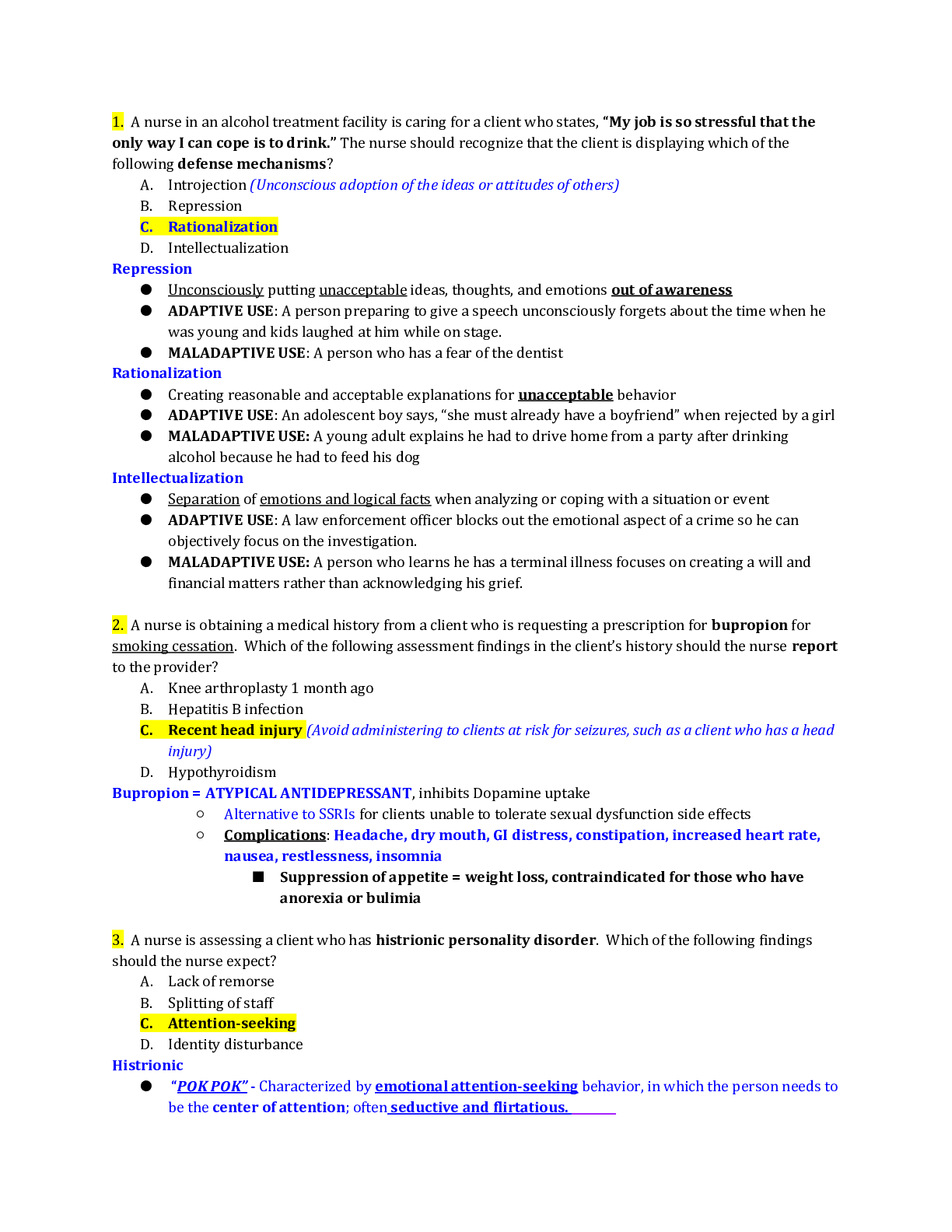
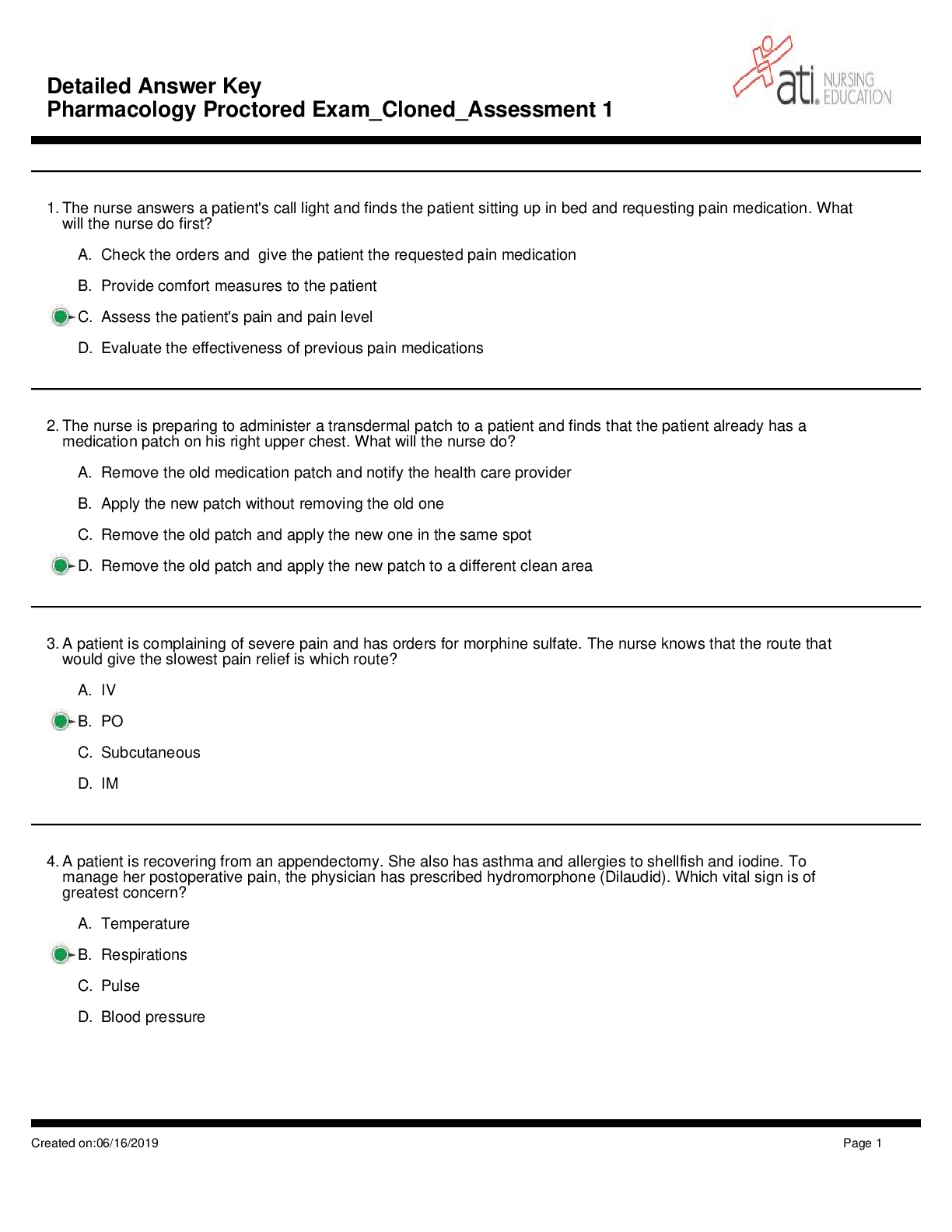
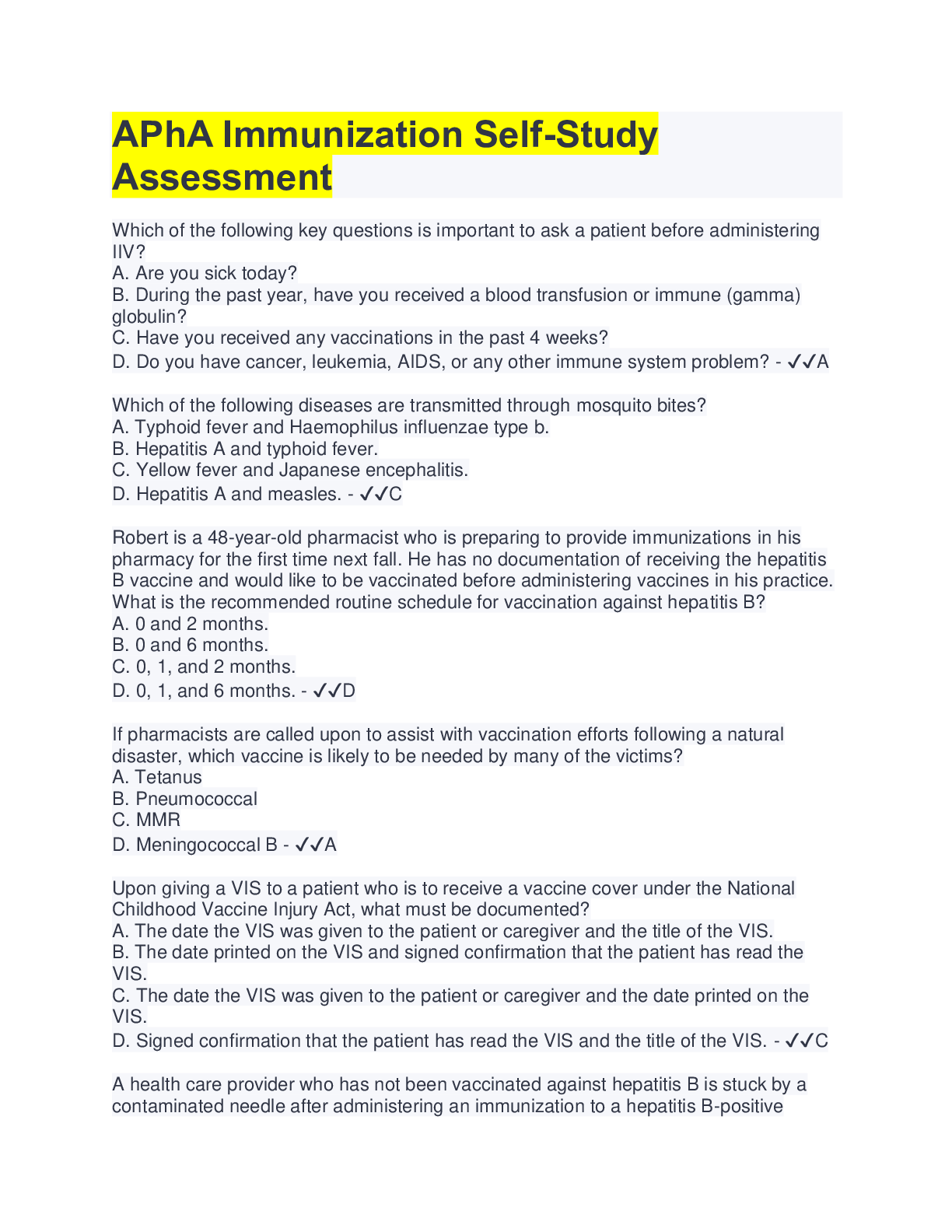
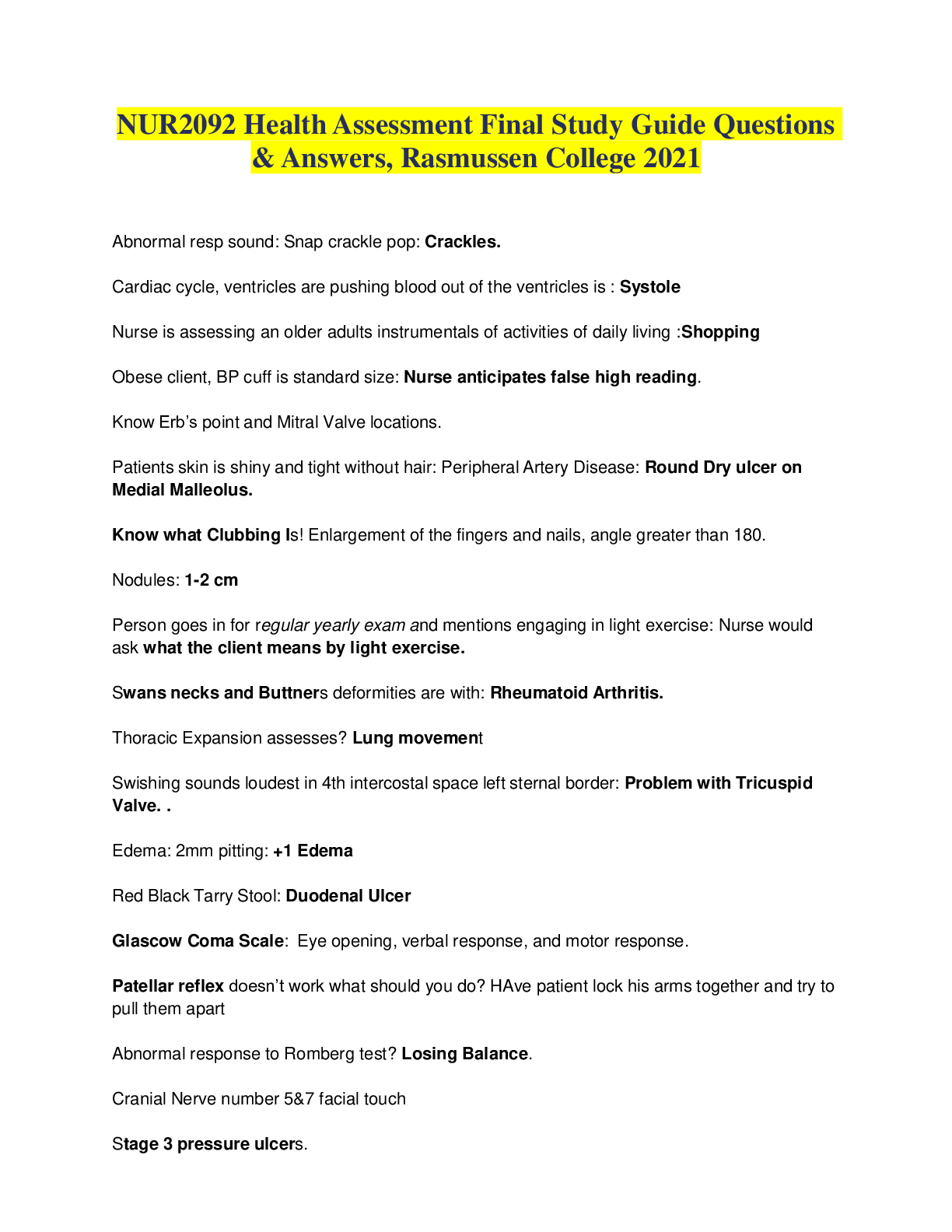
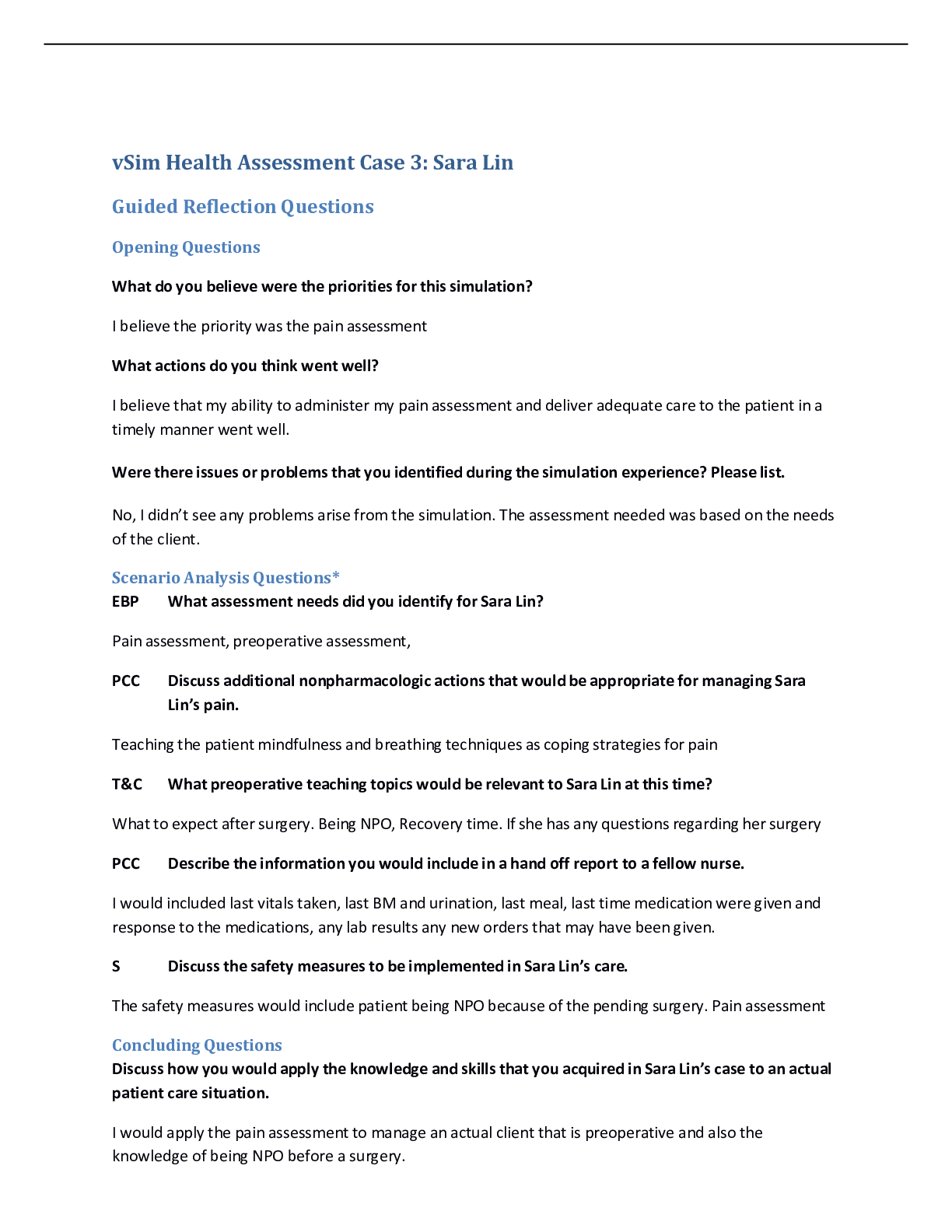
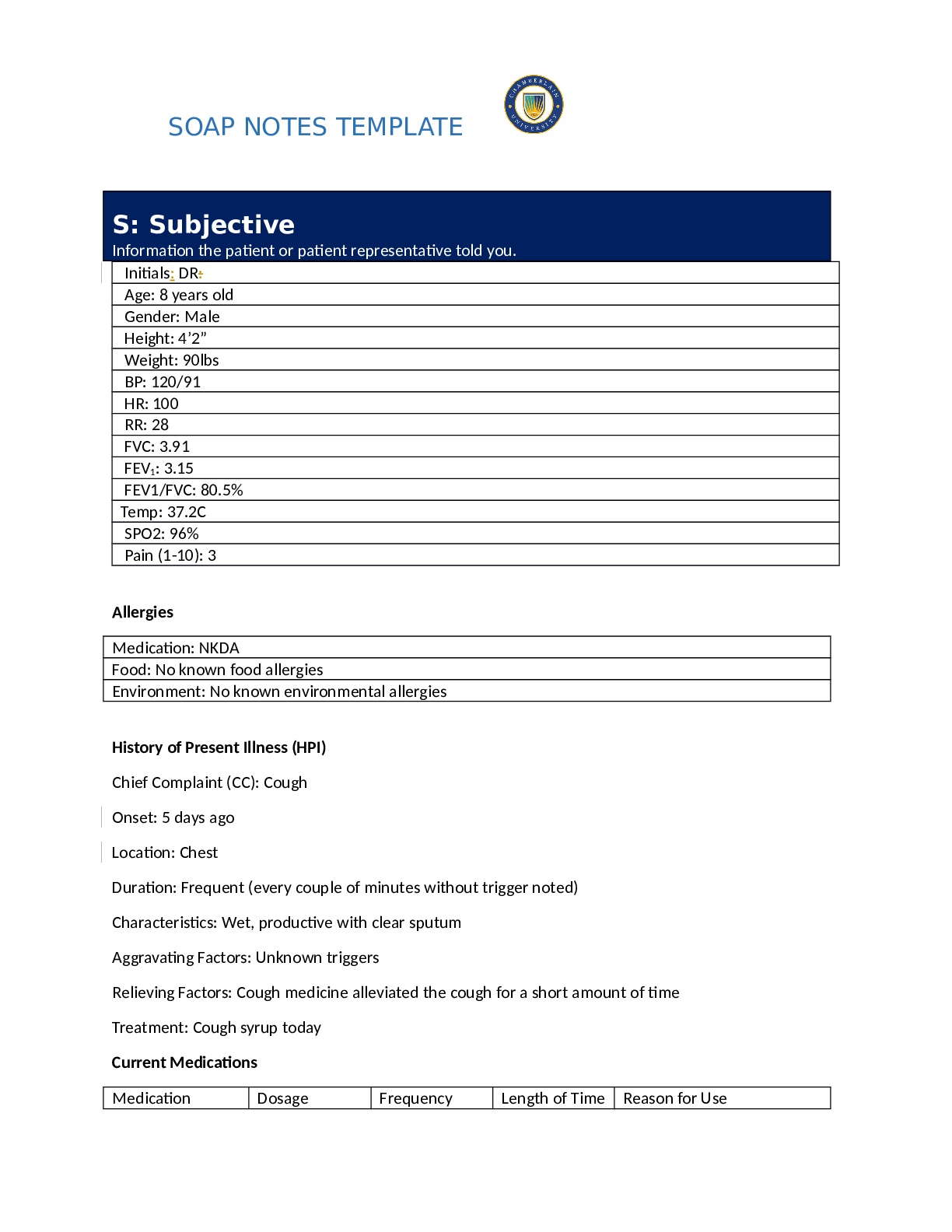

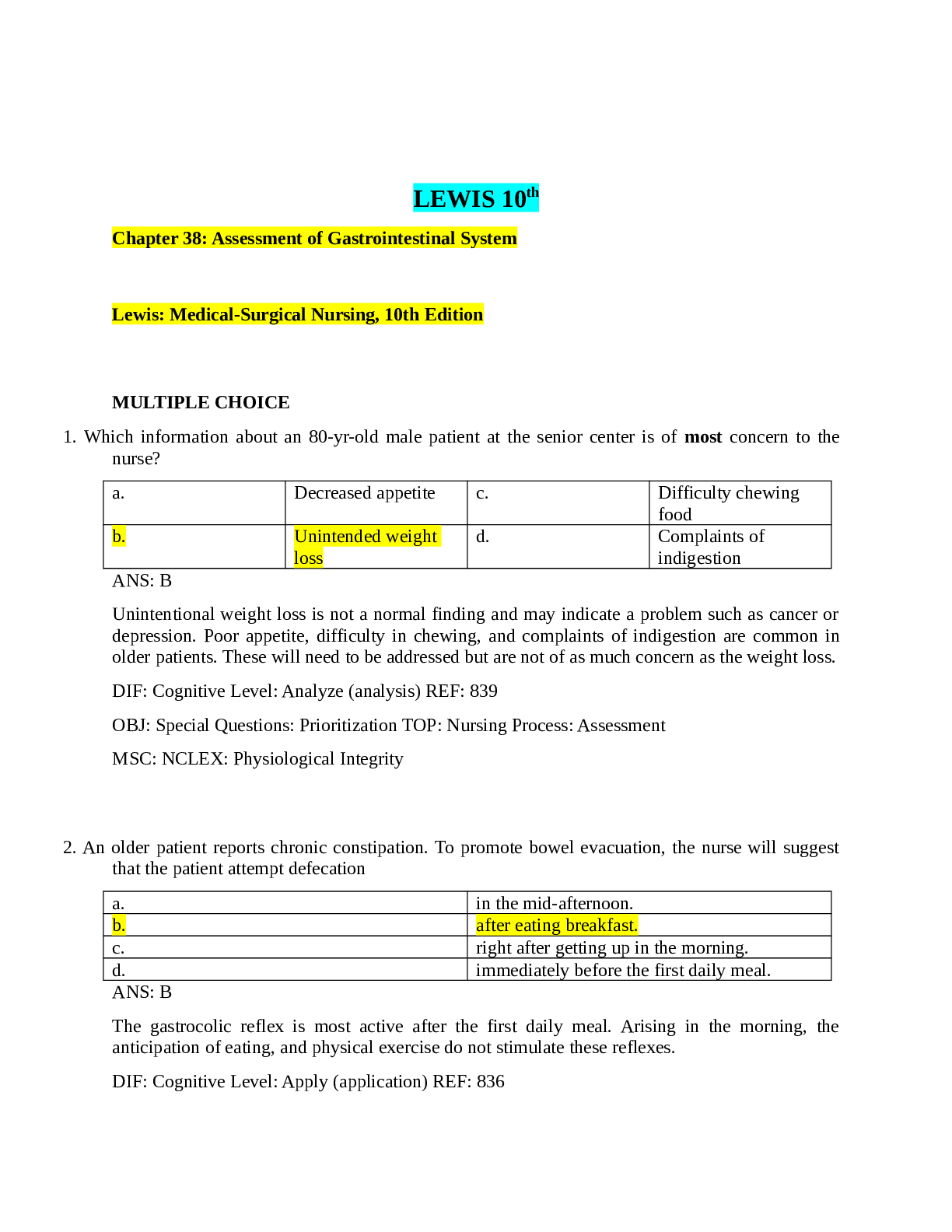


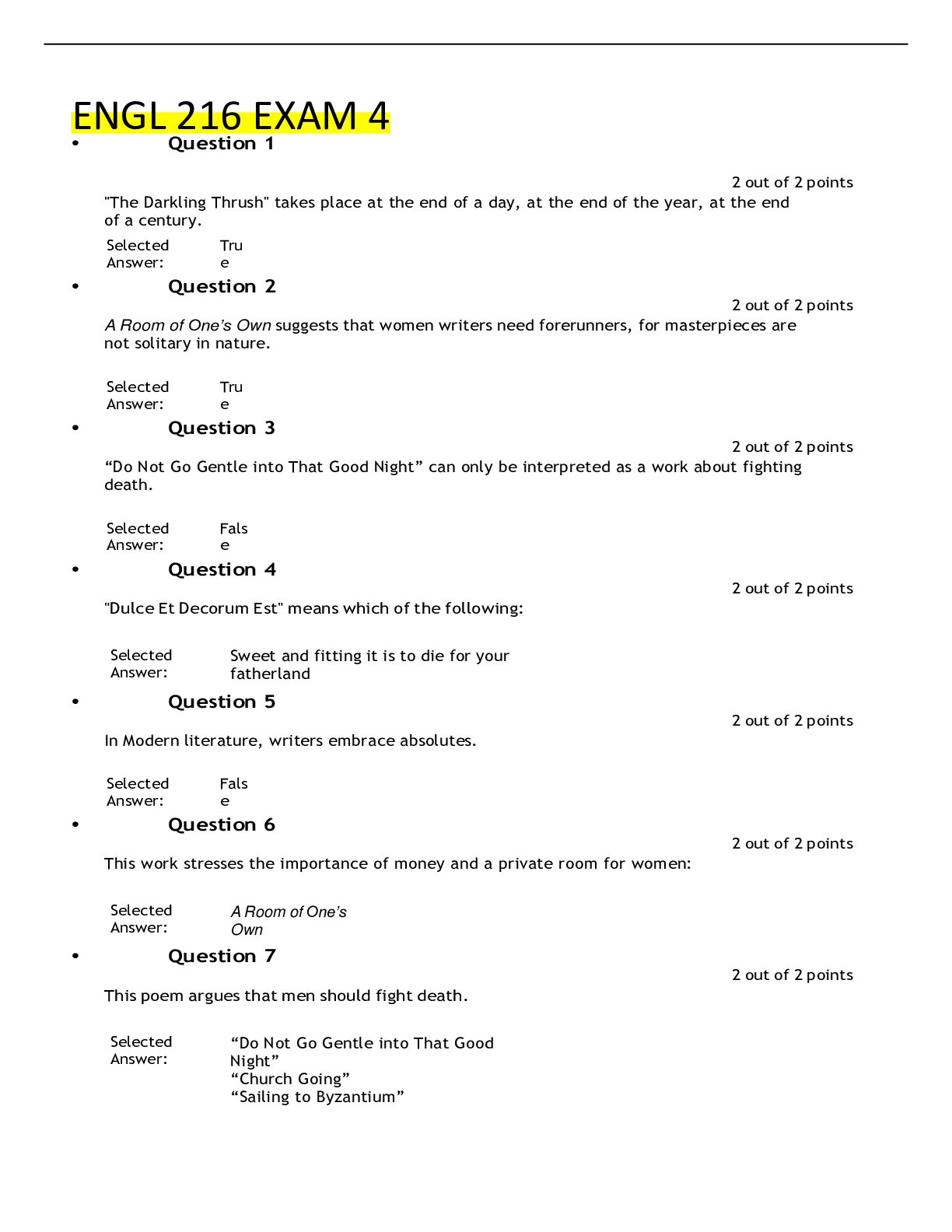
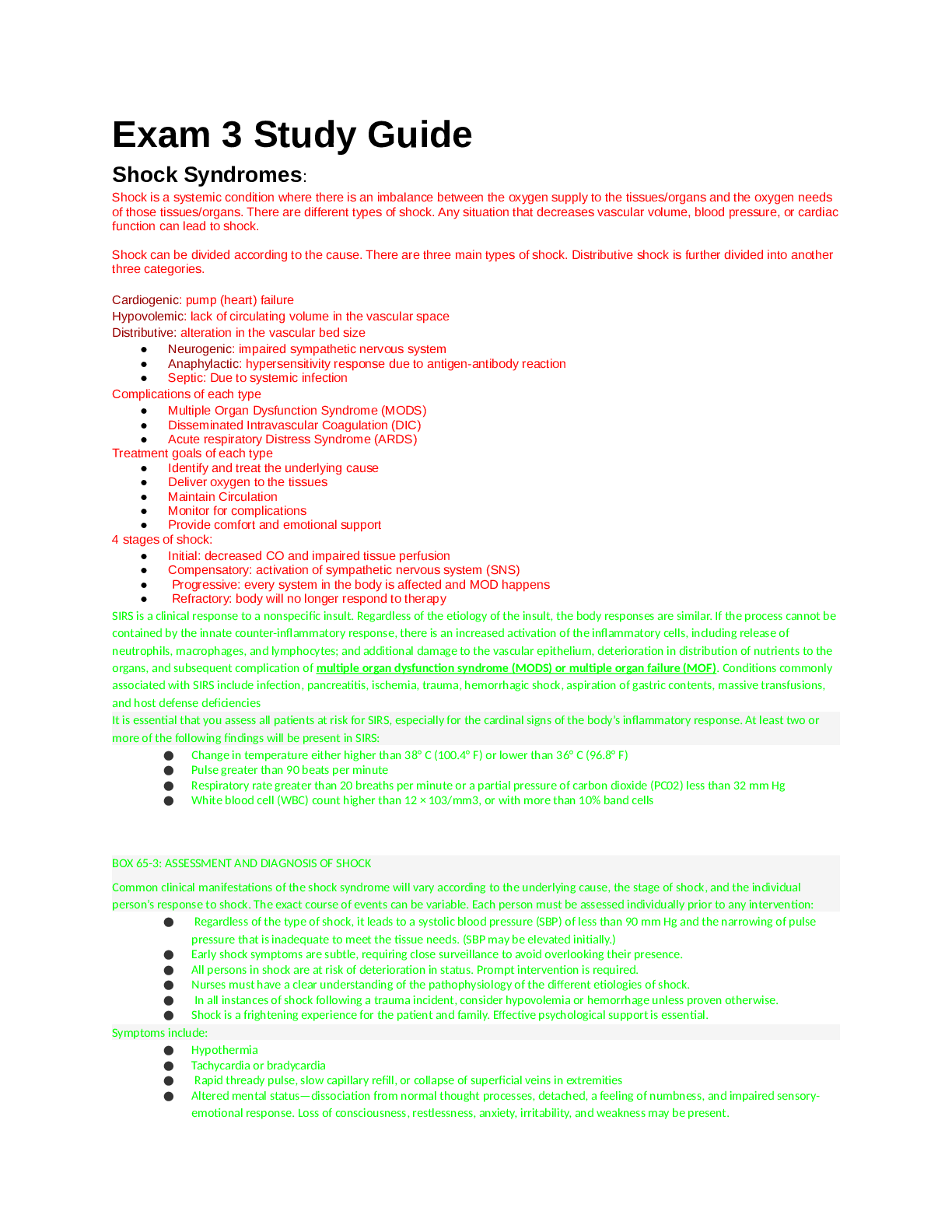
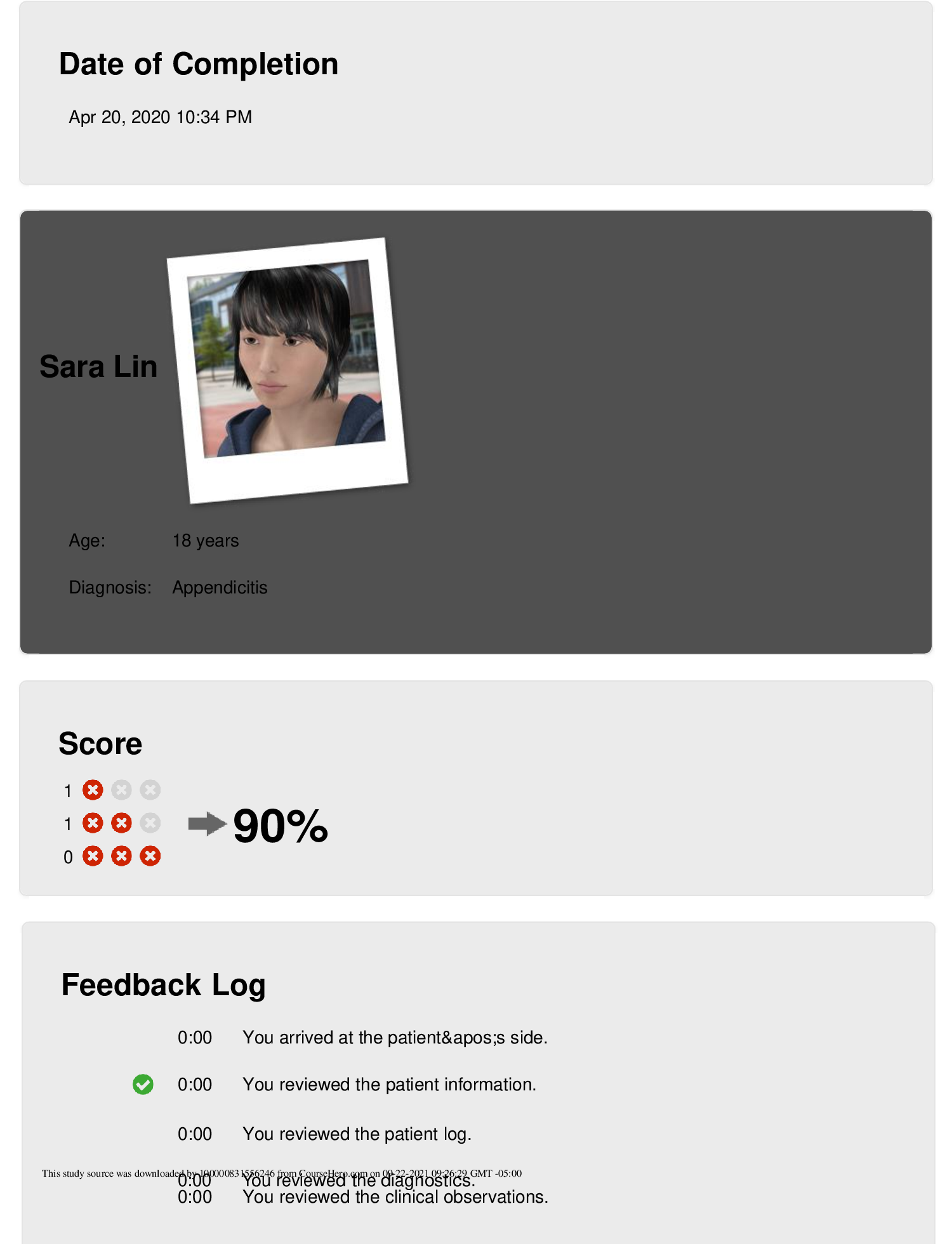



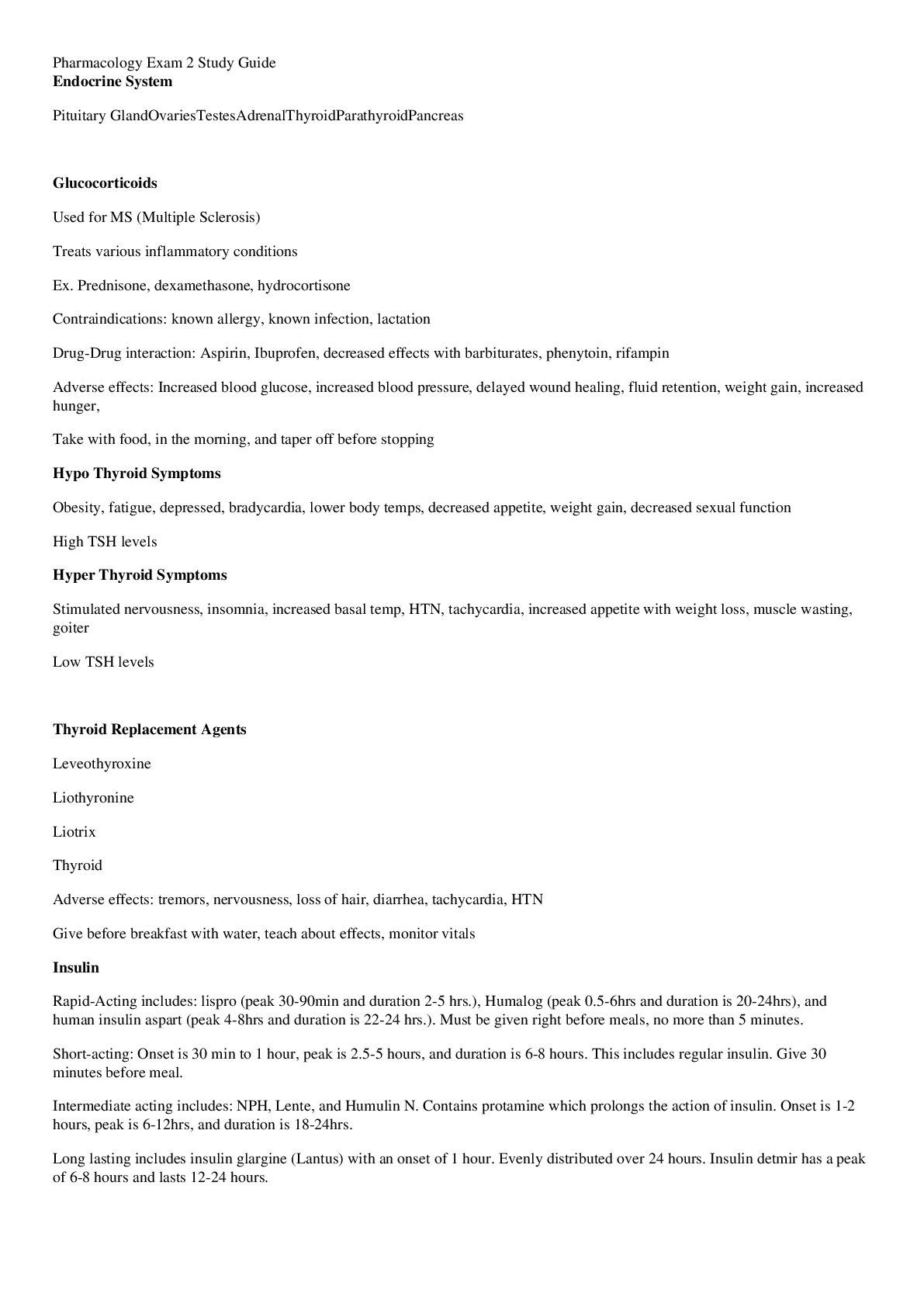
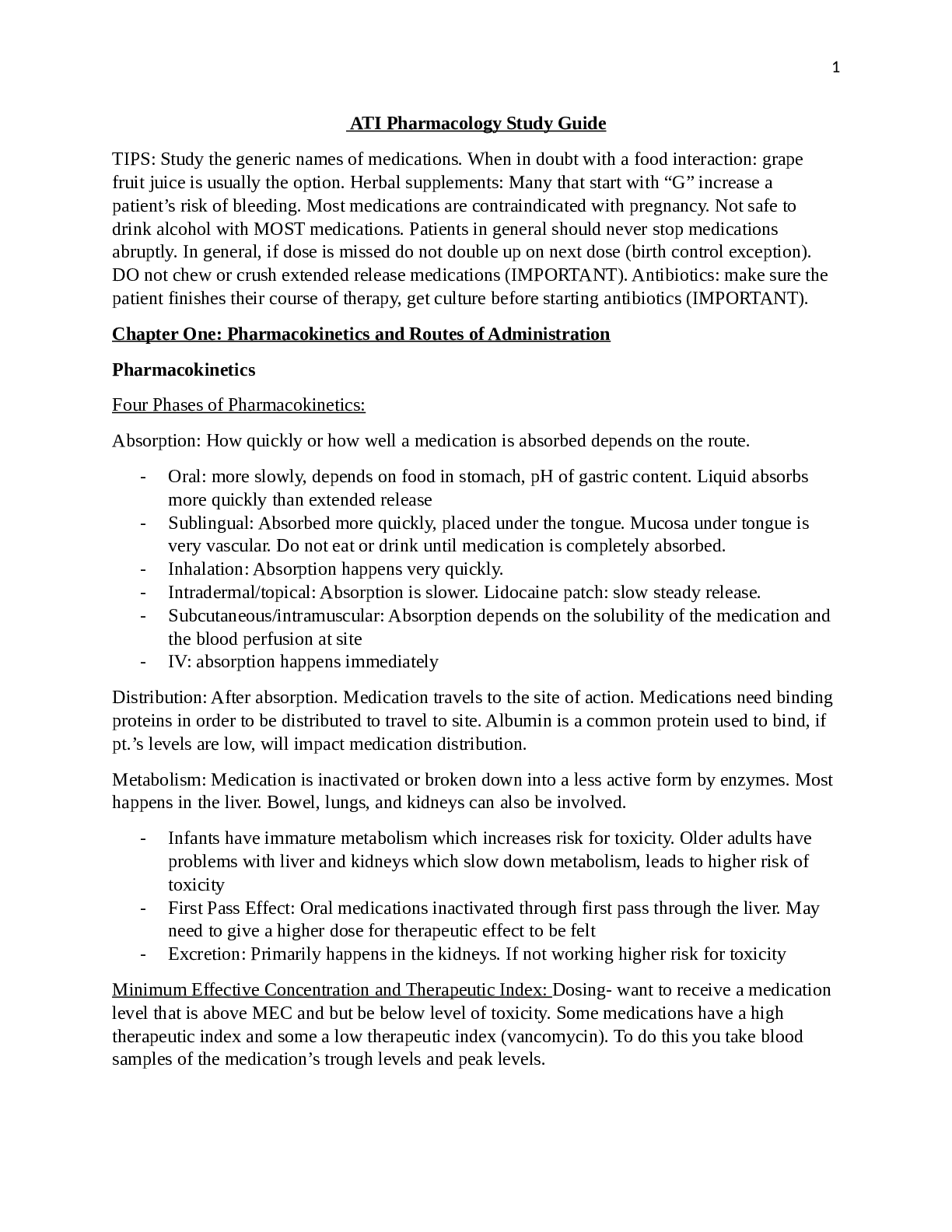
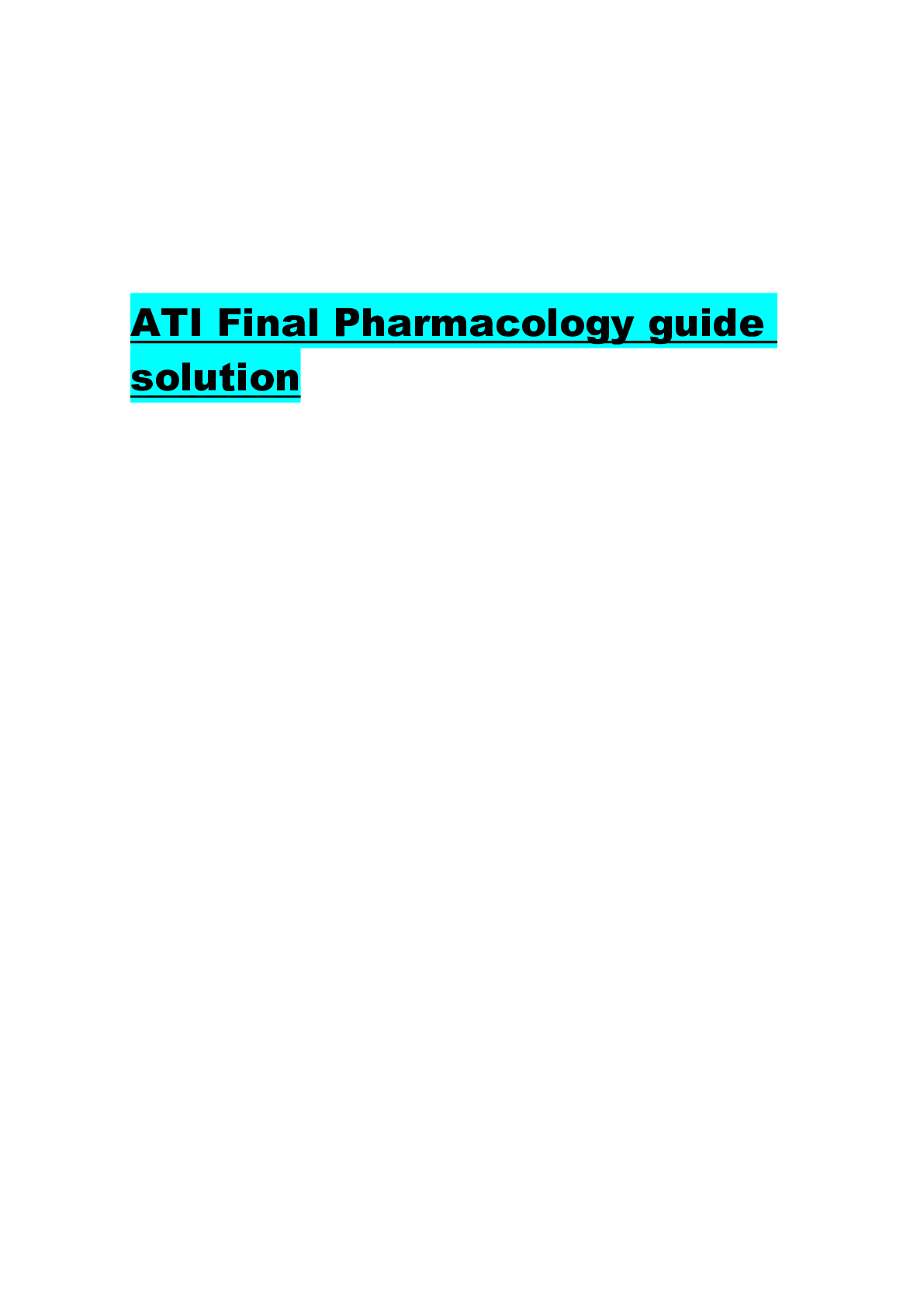
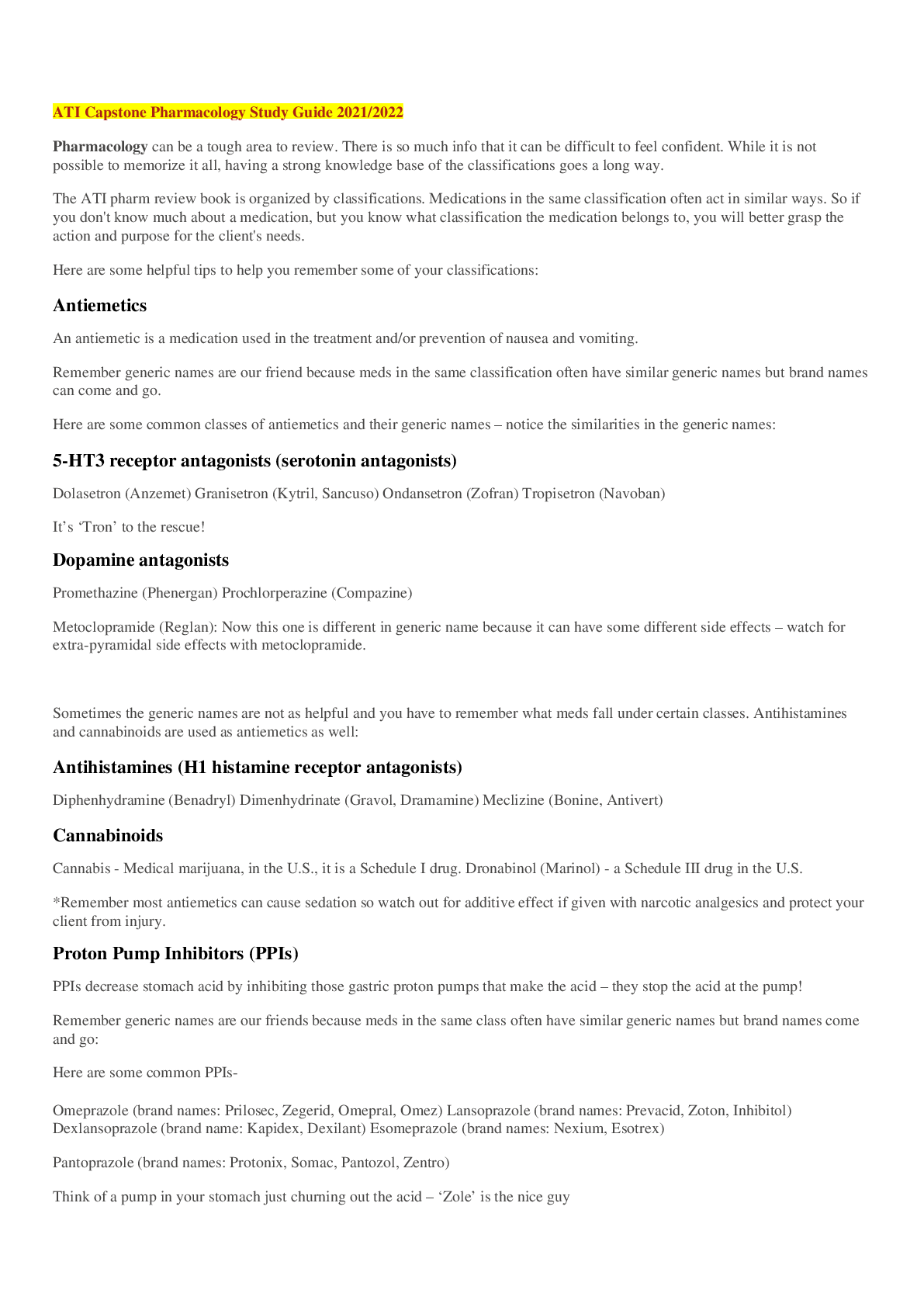
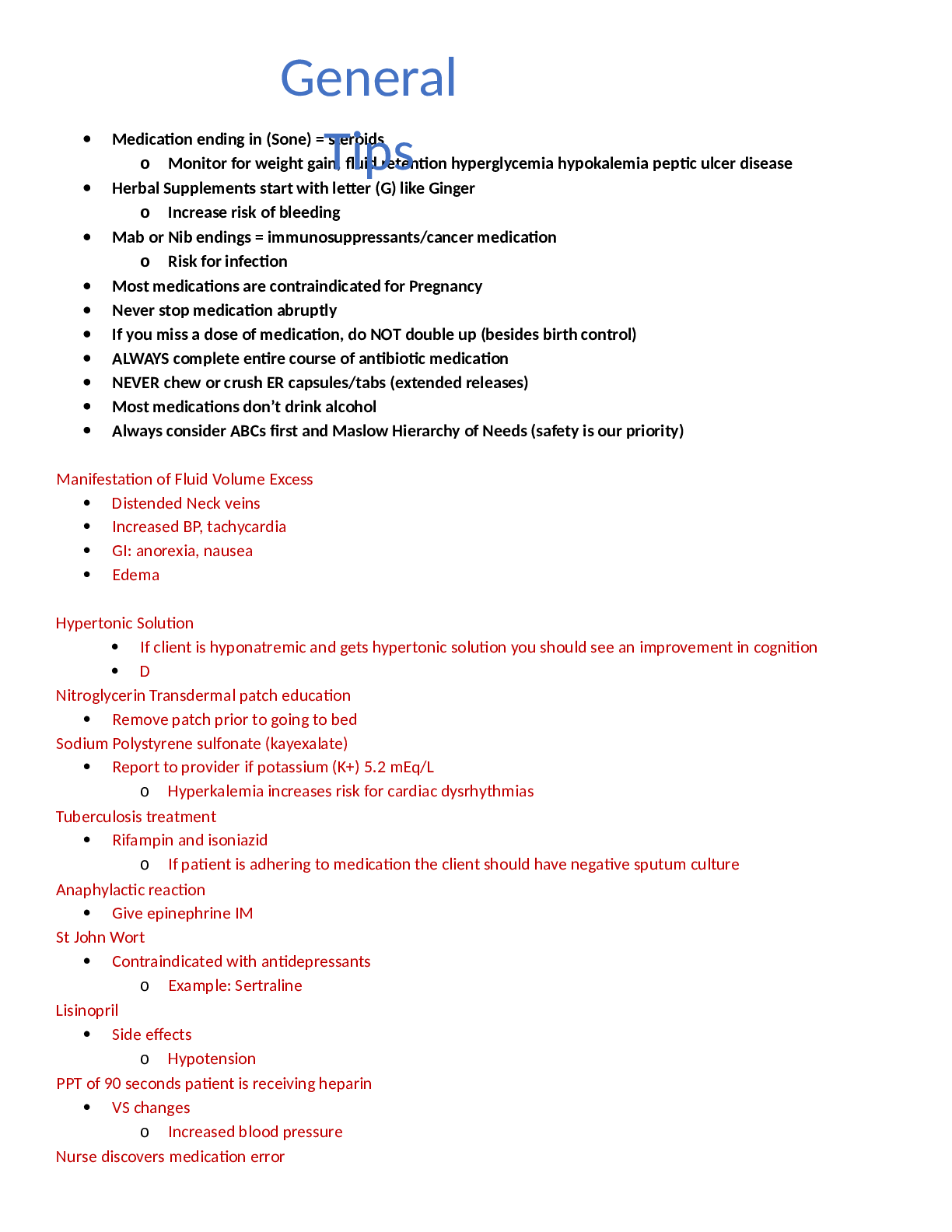
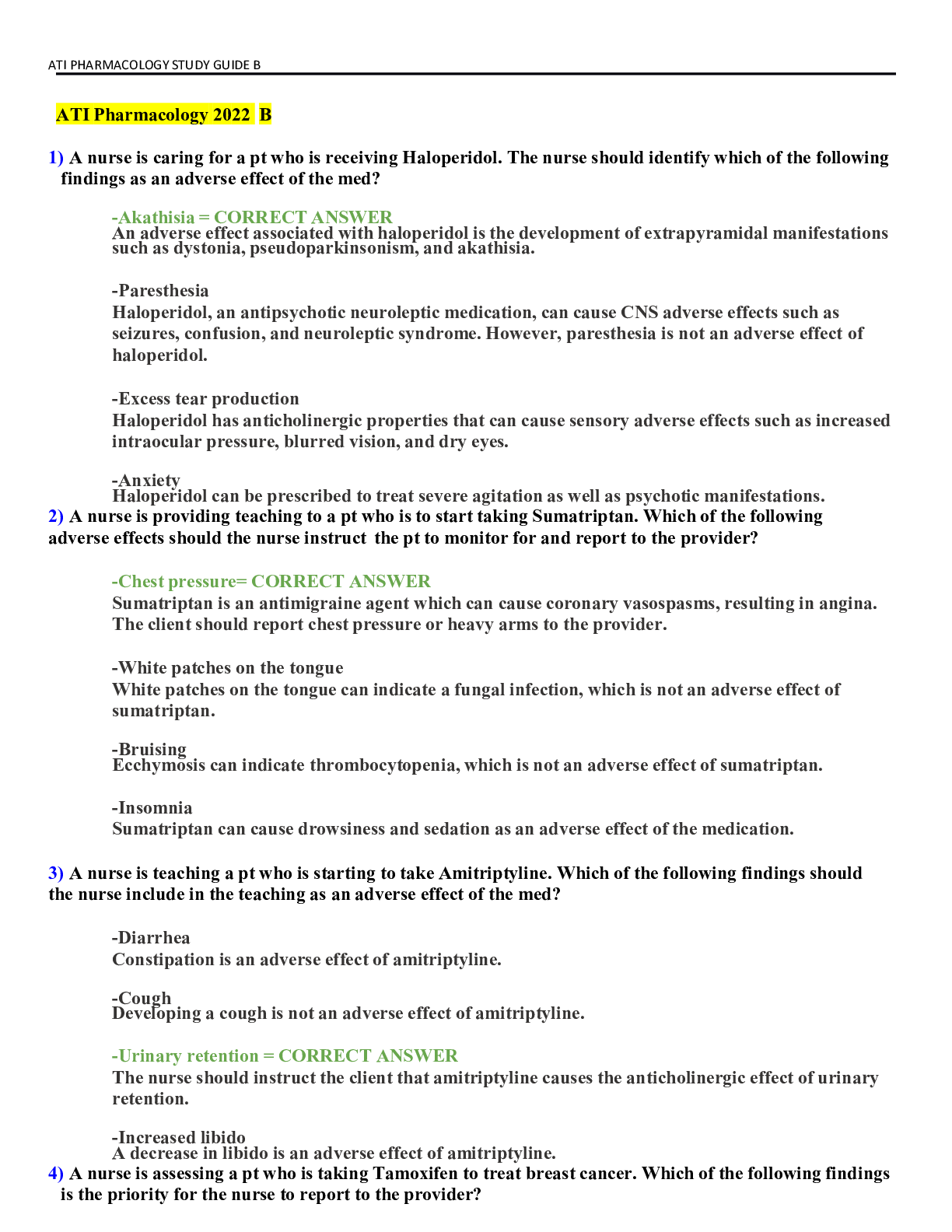
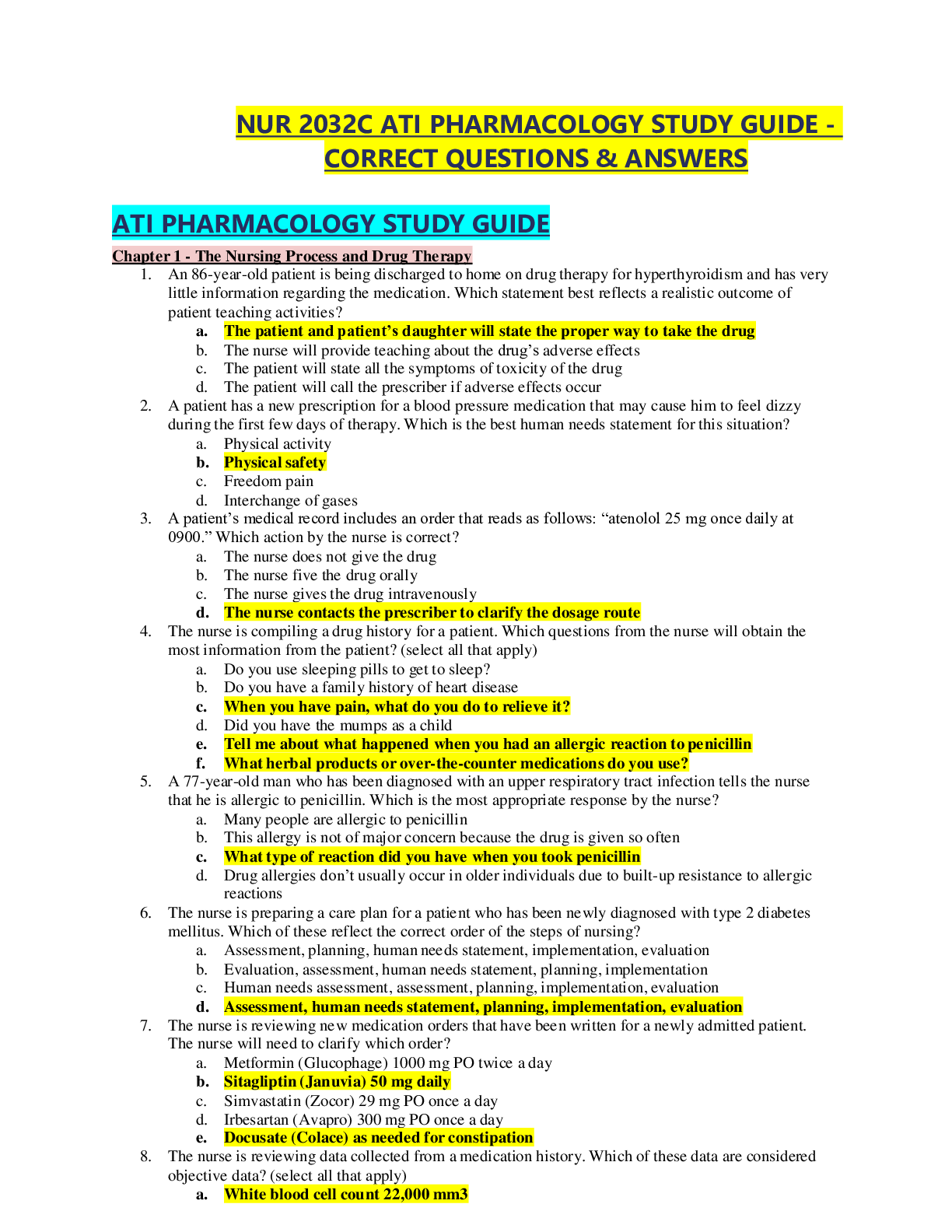
 (1).png)

